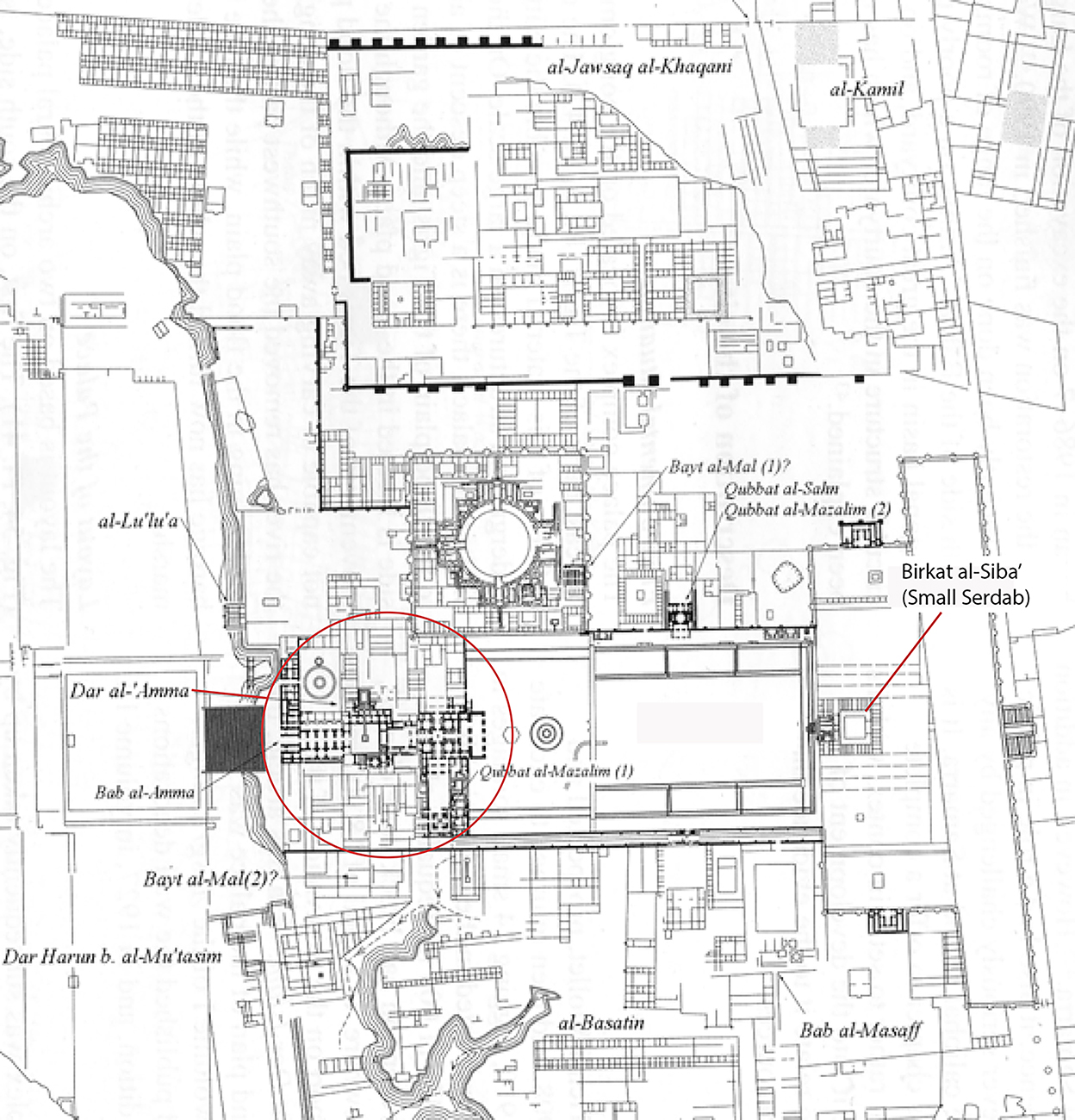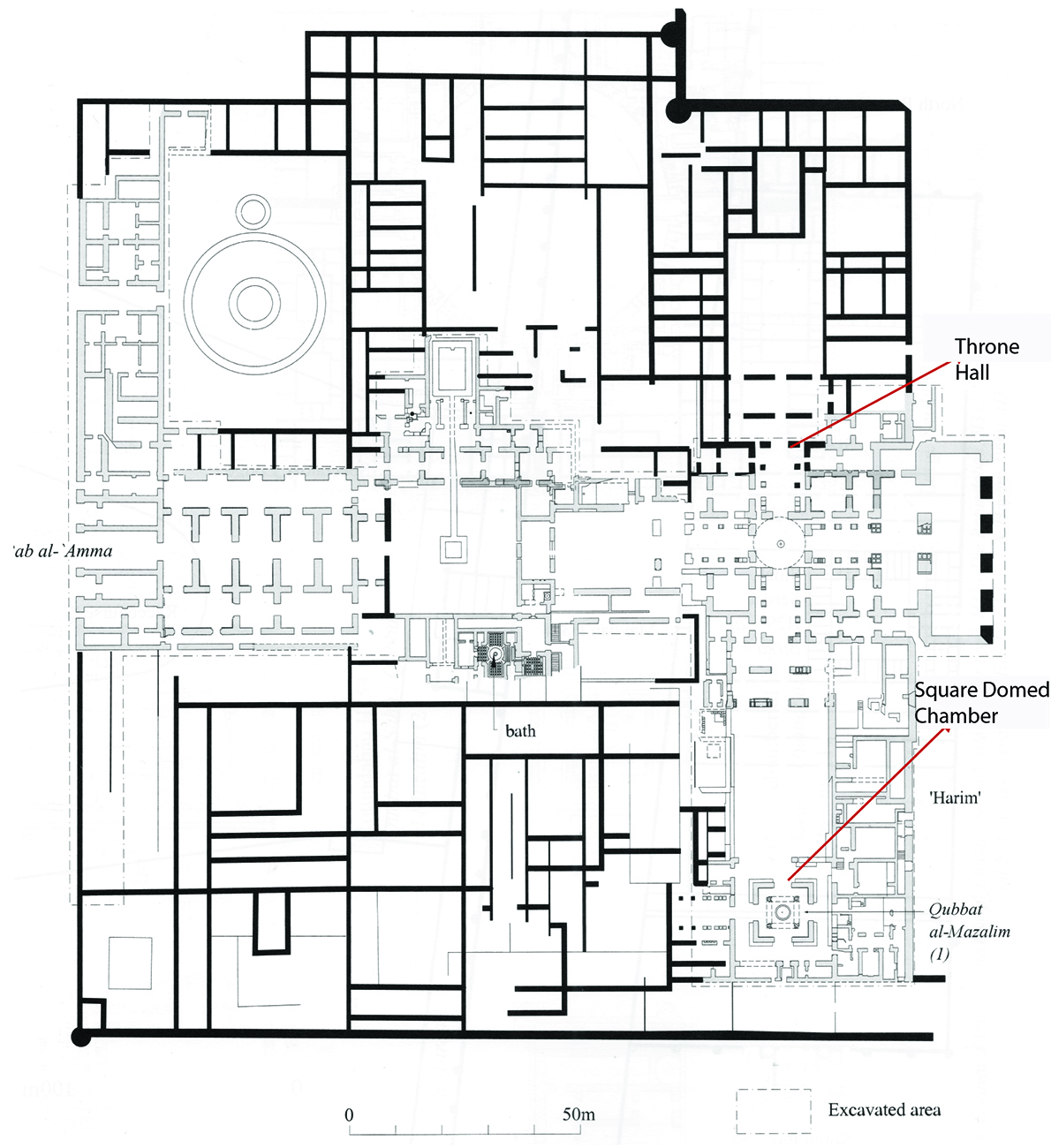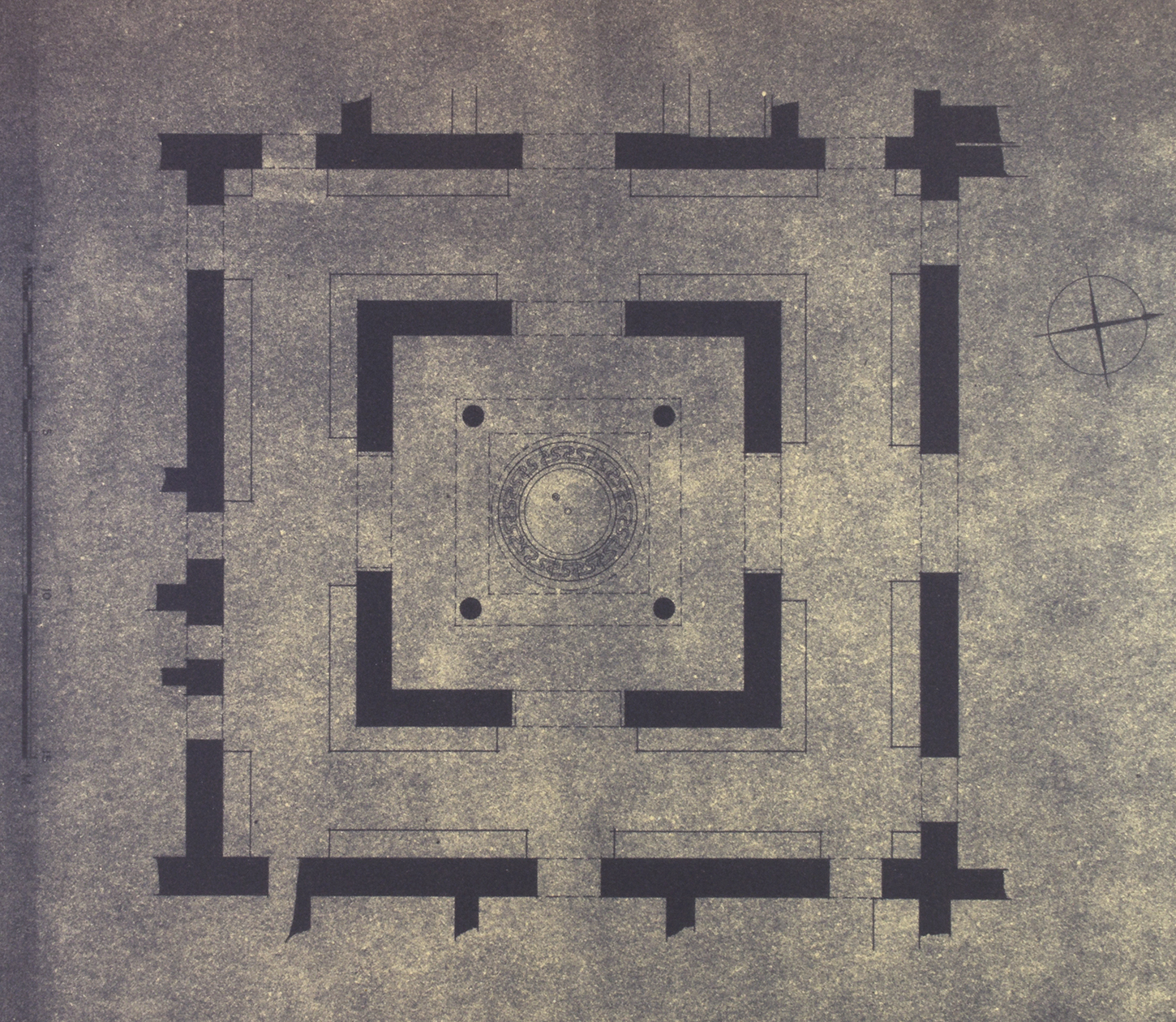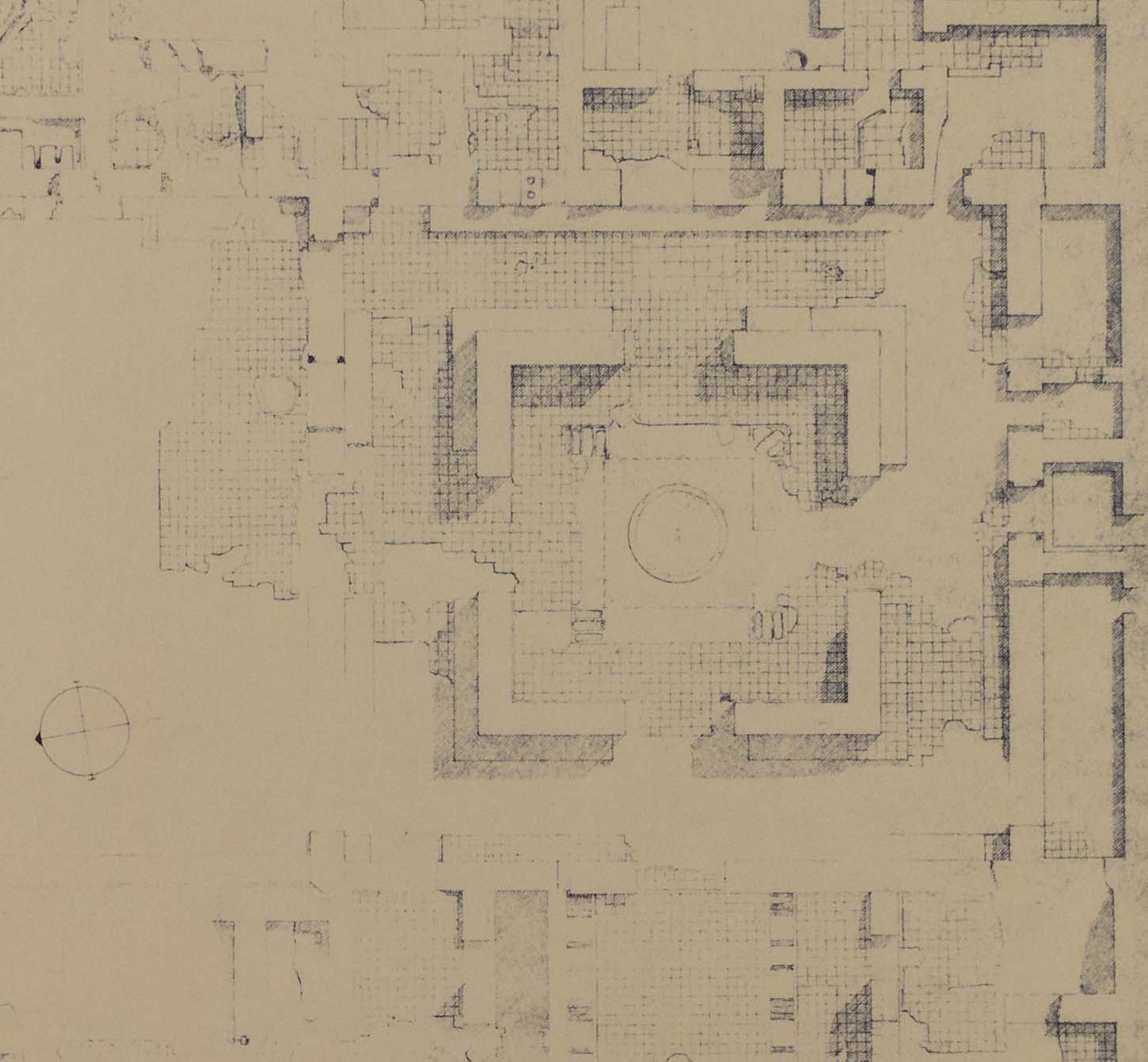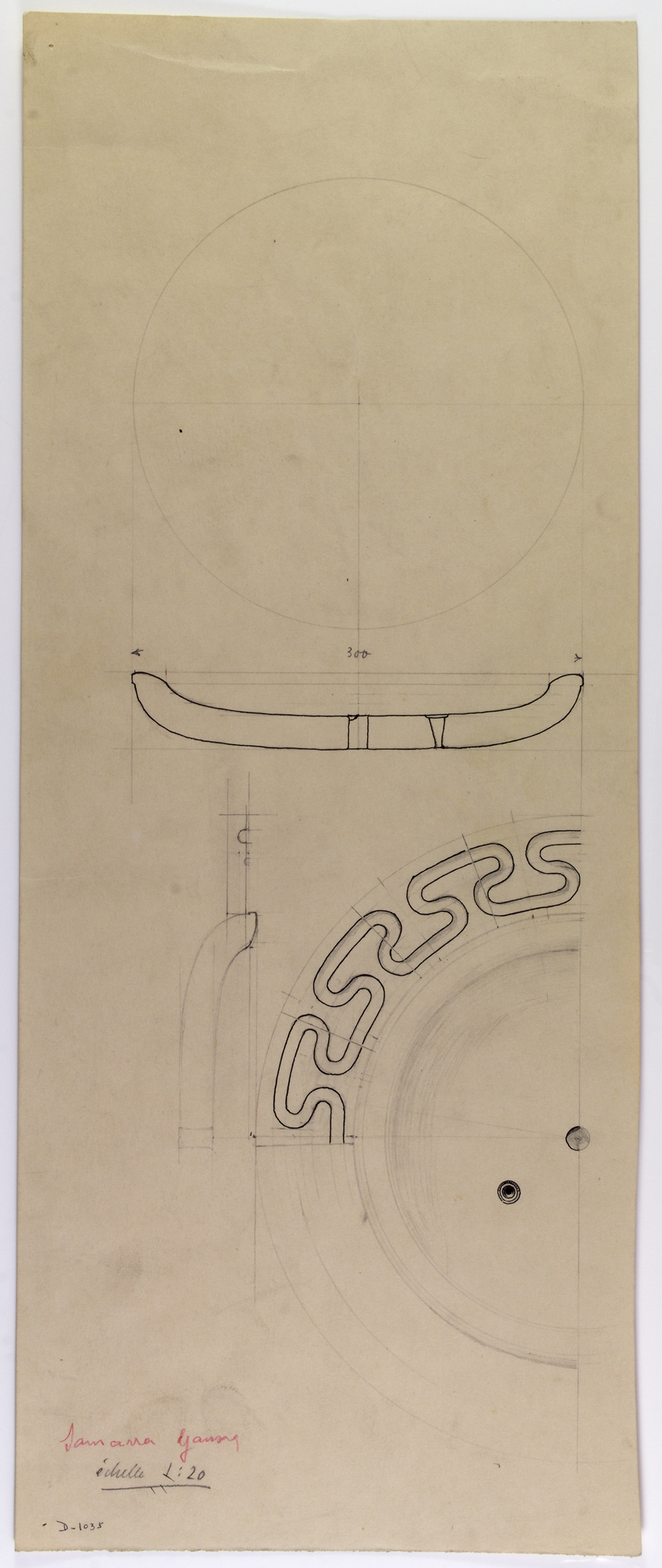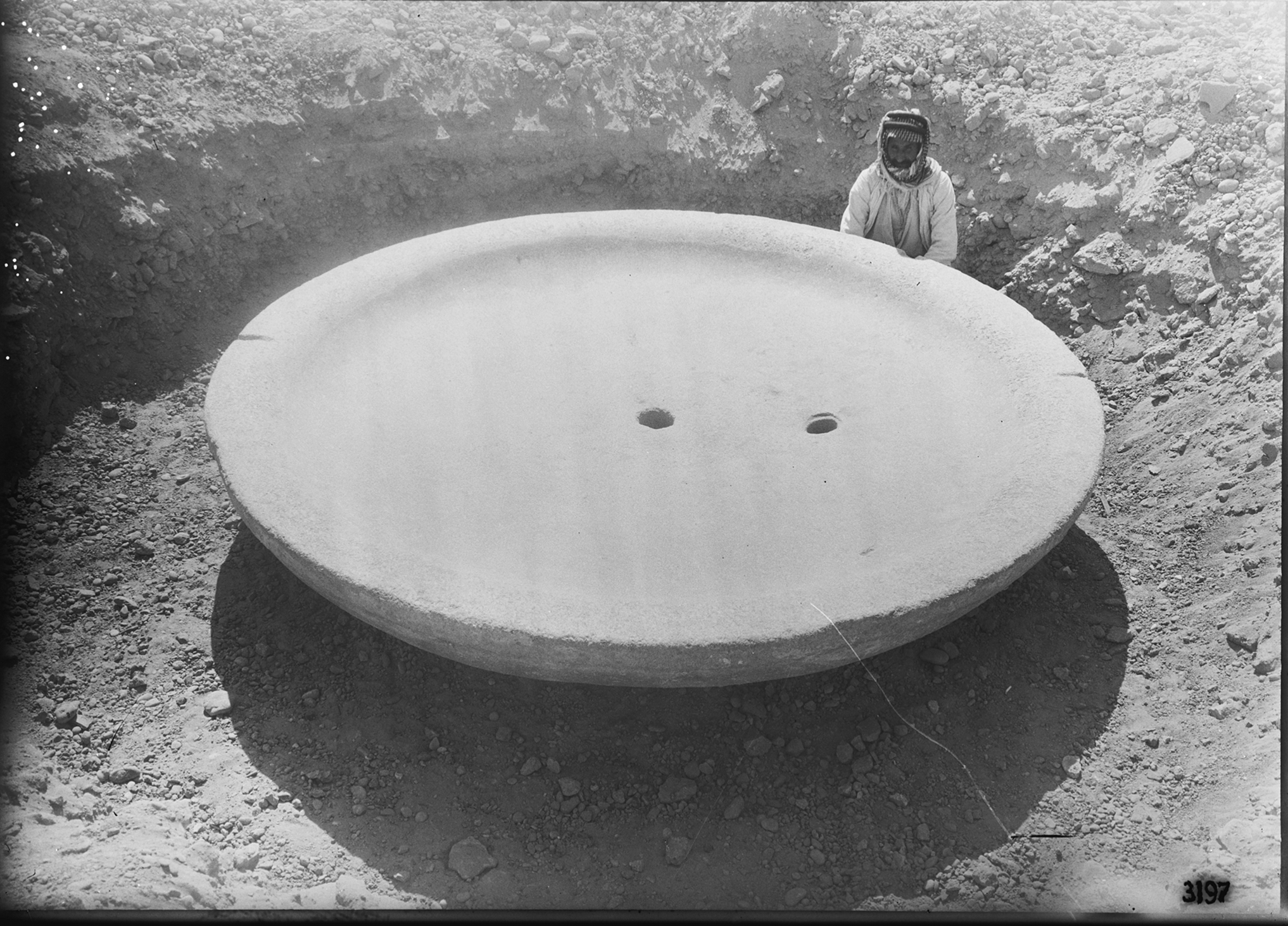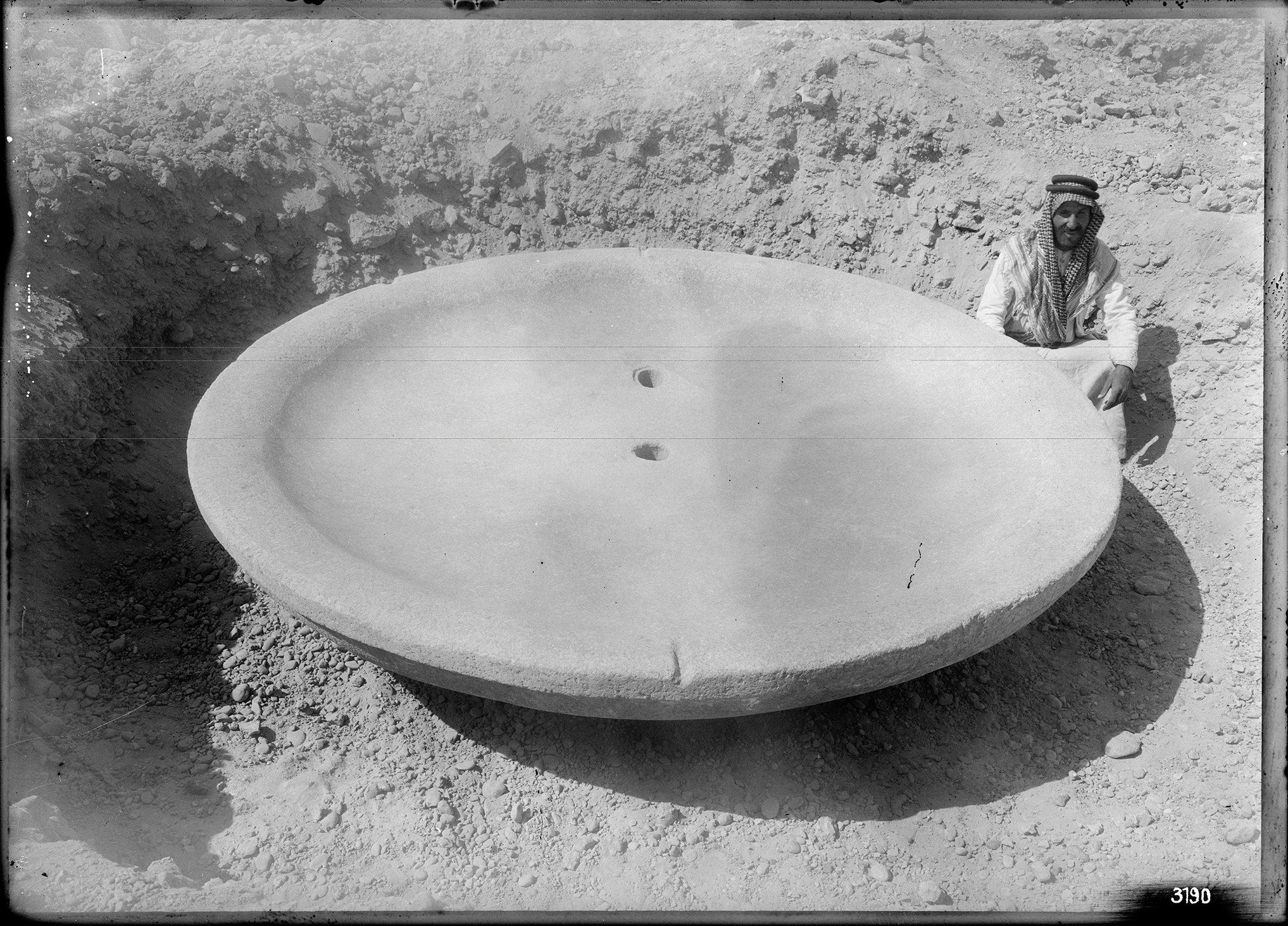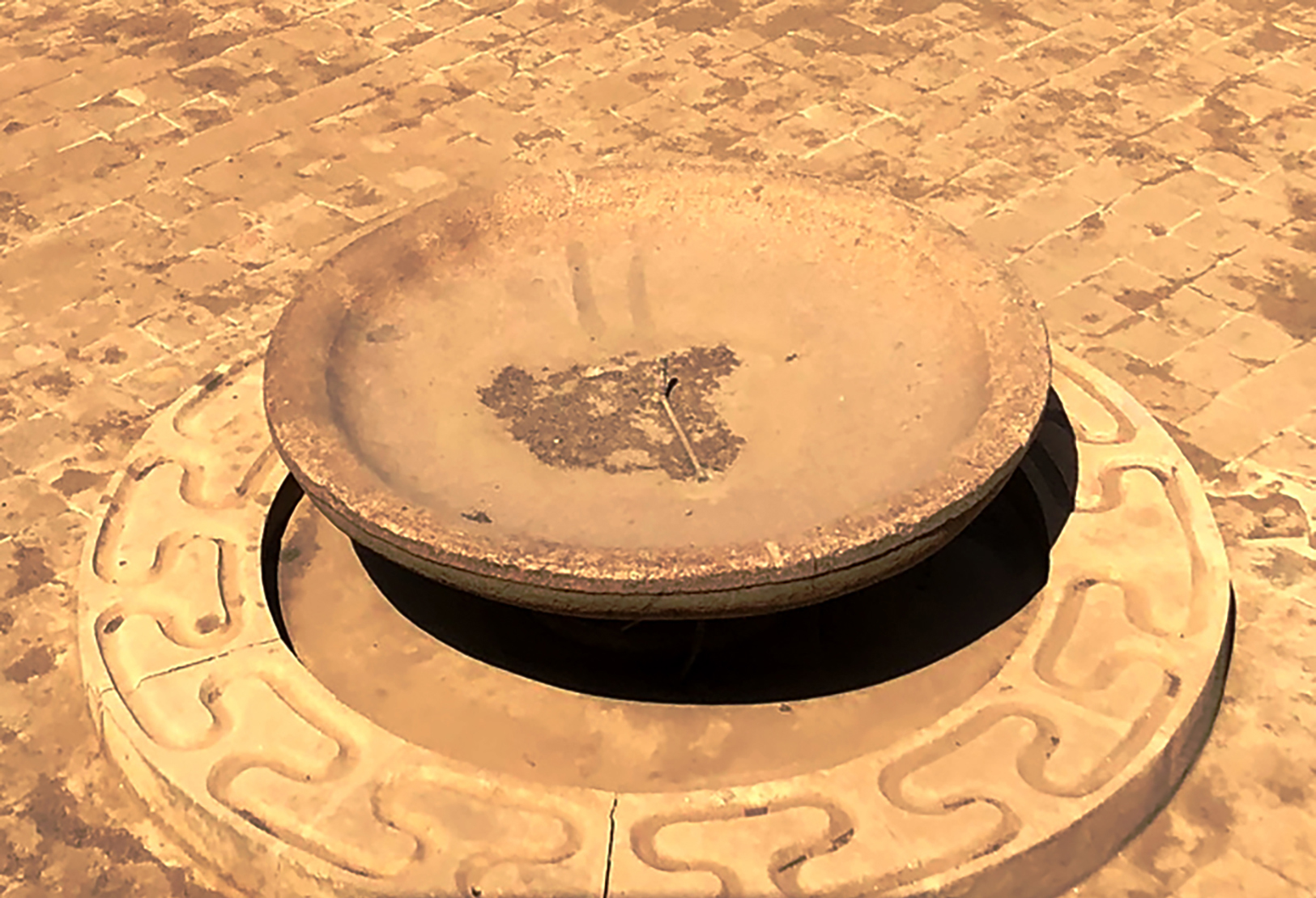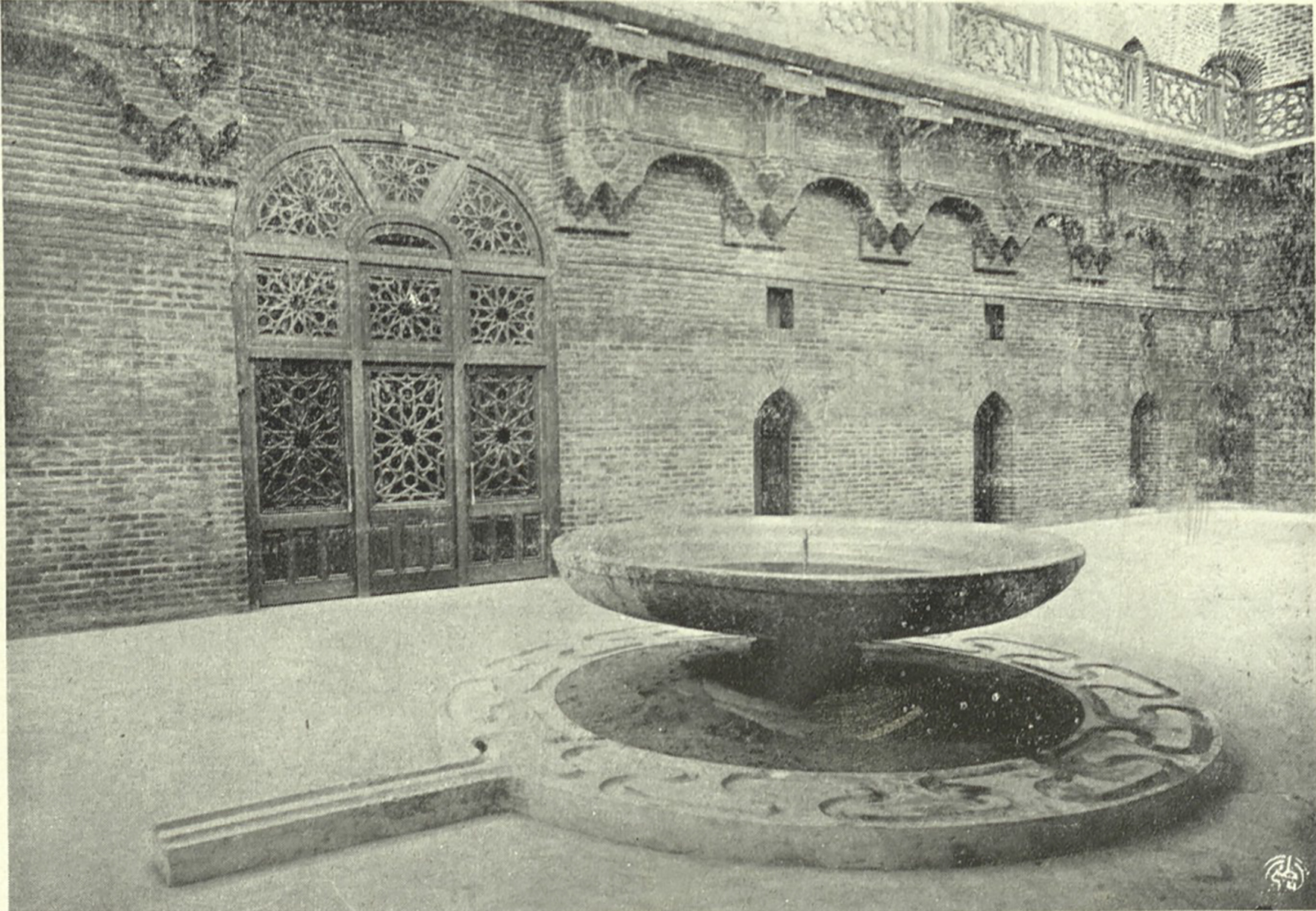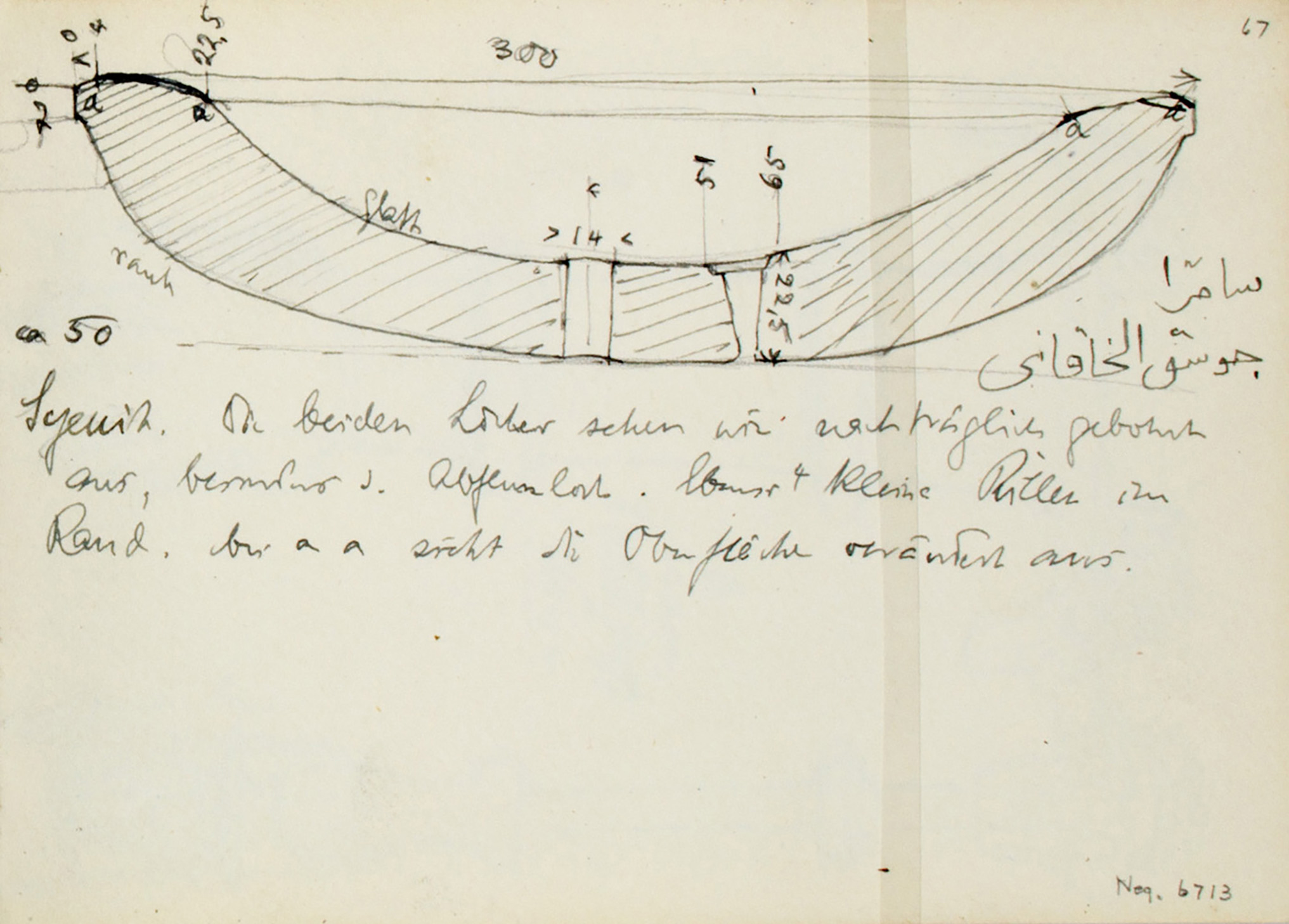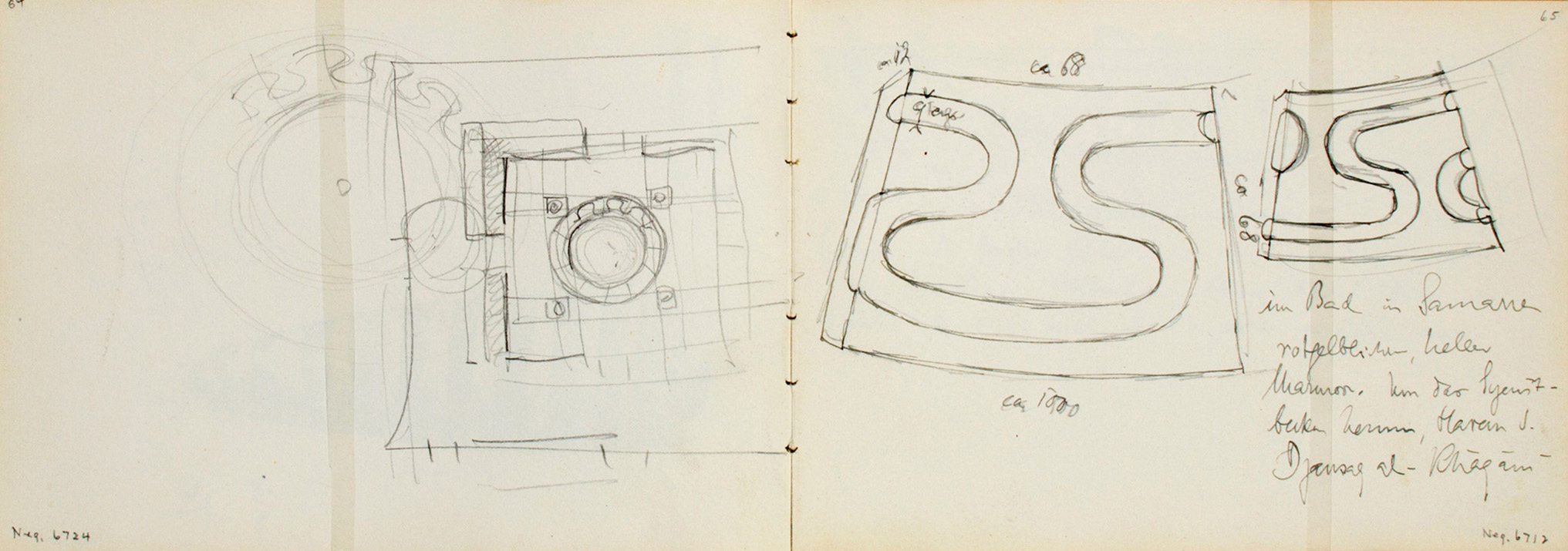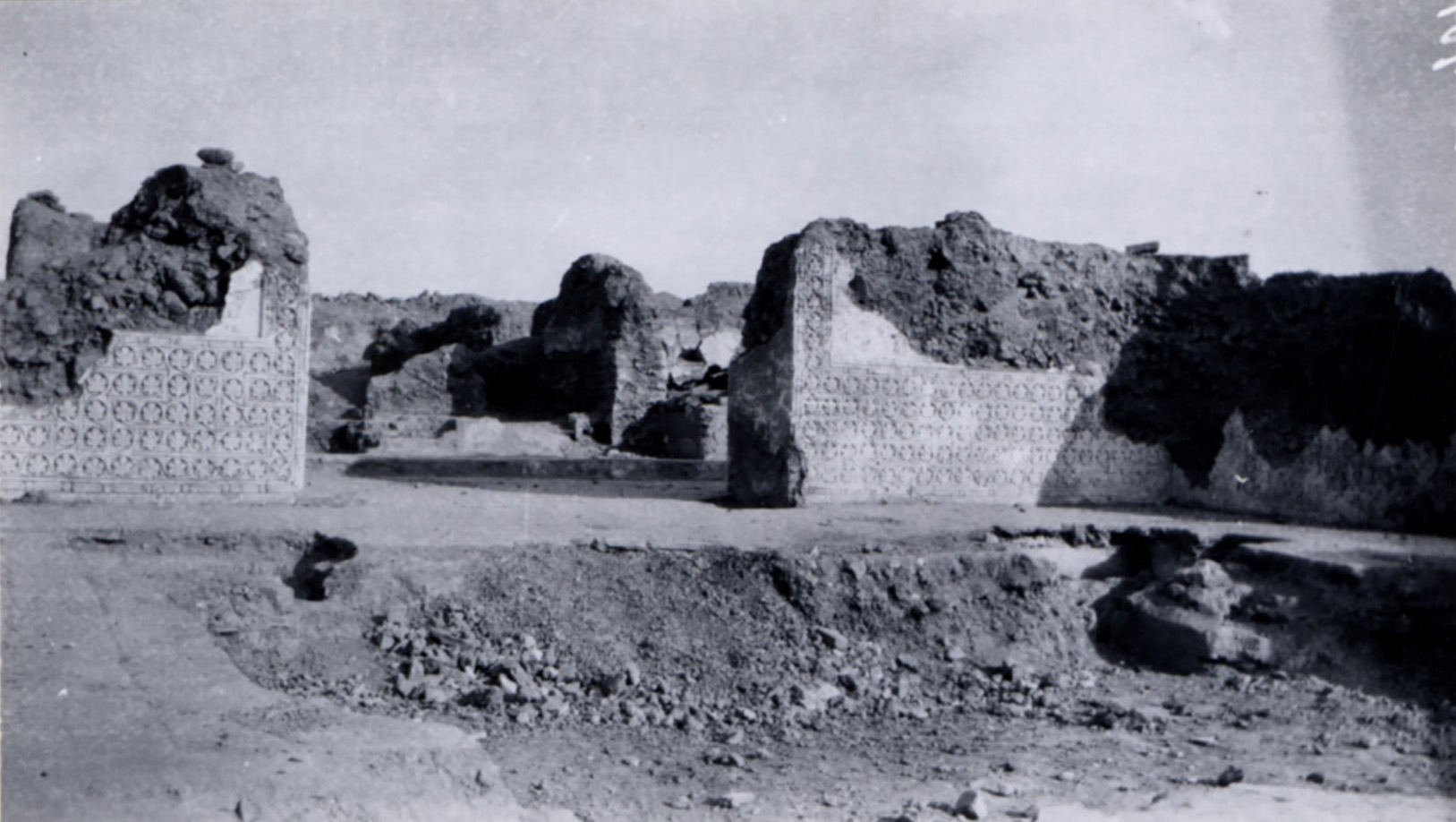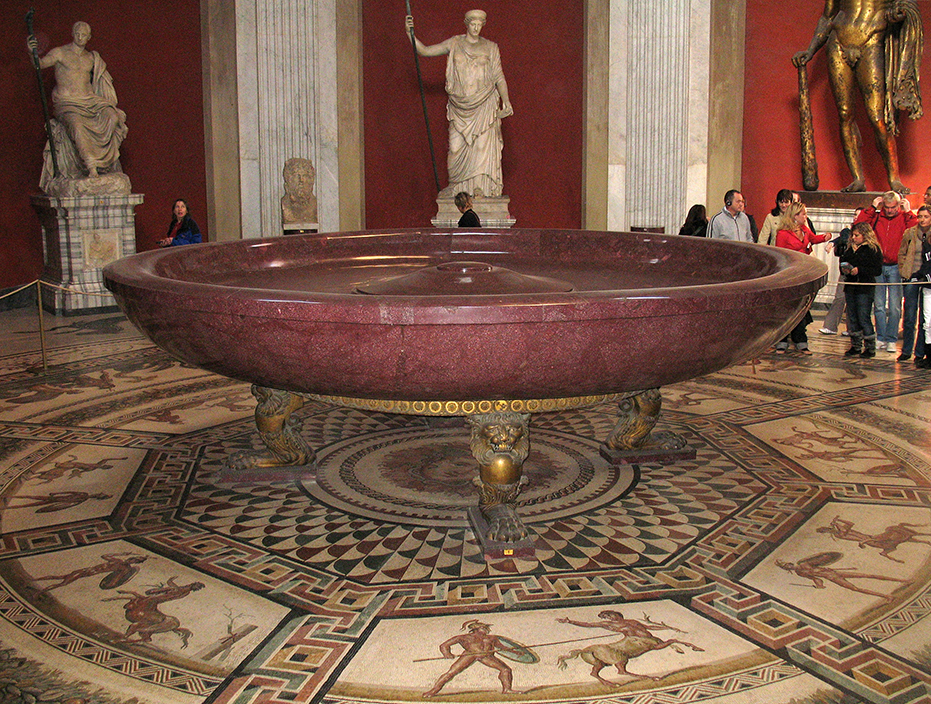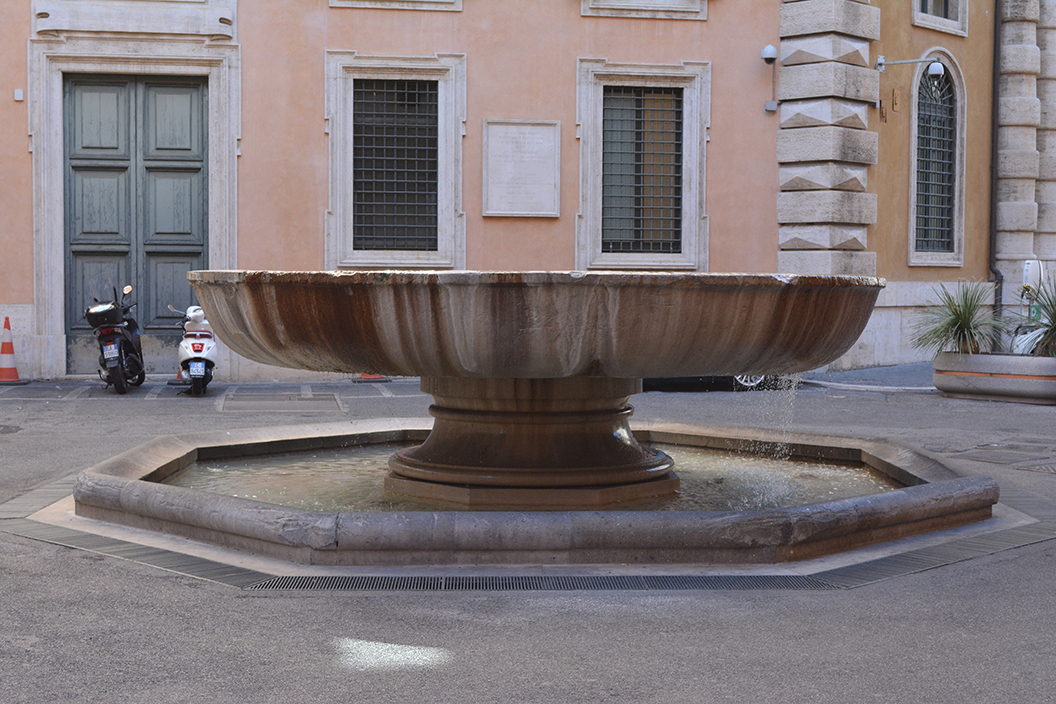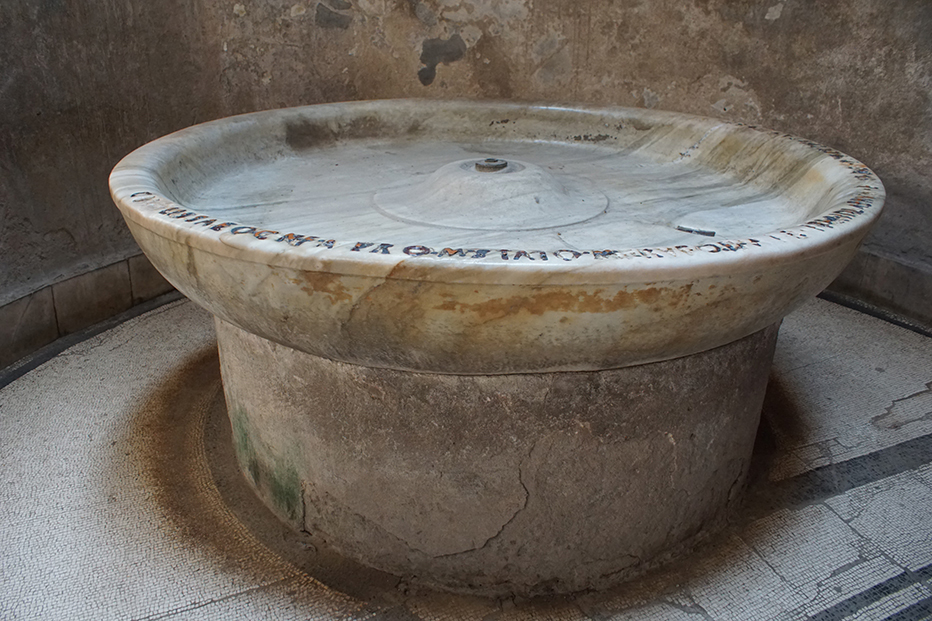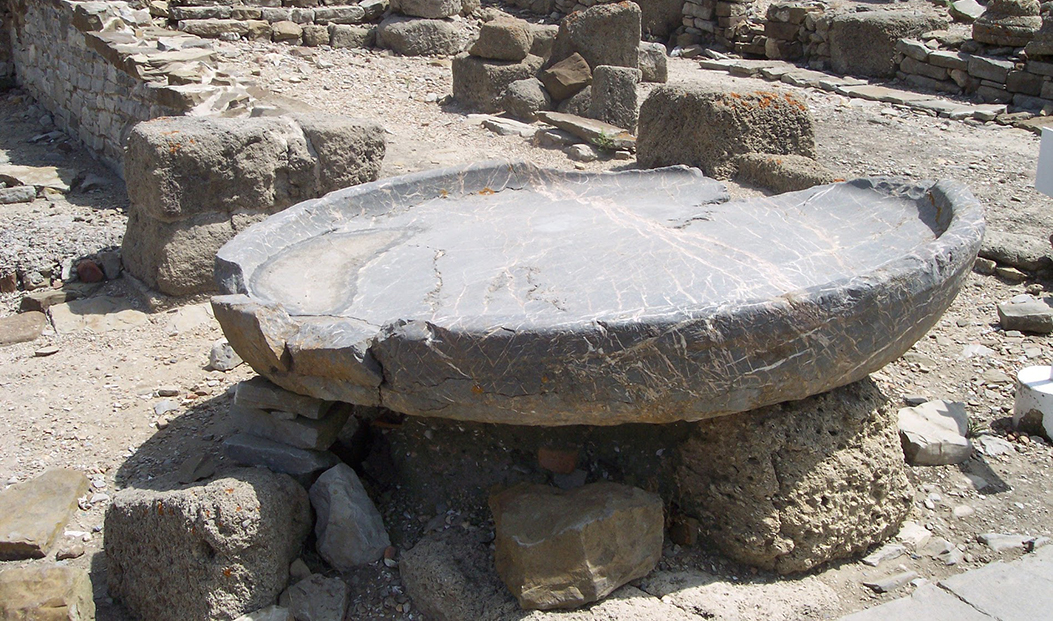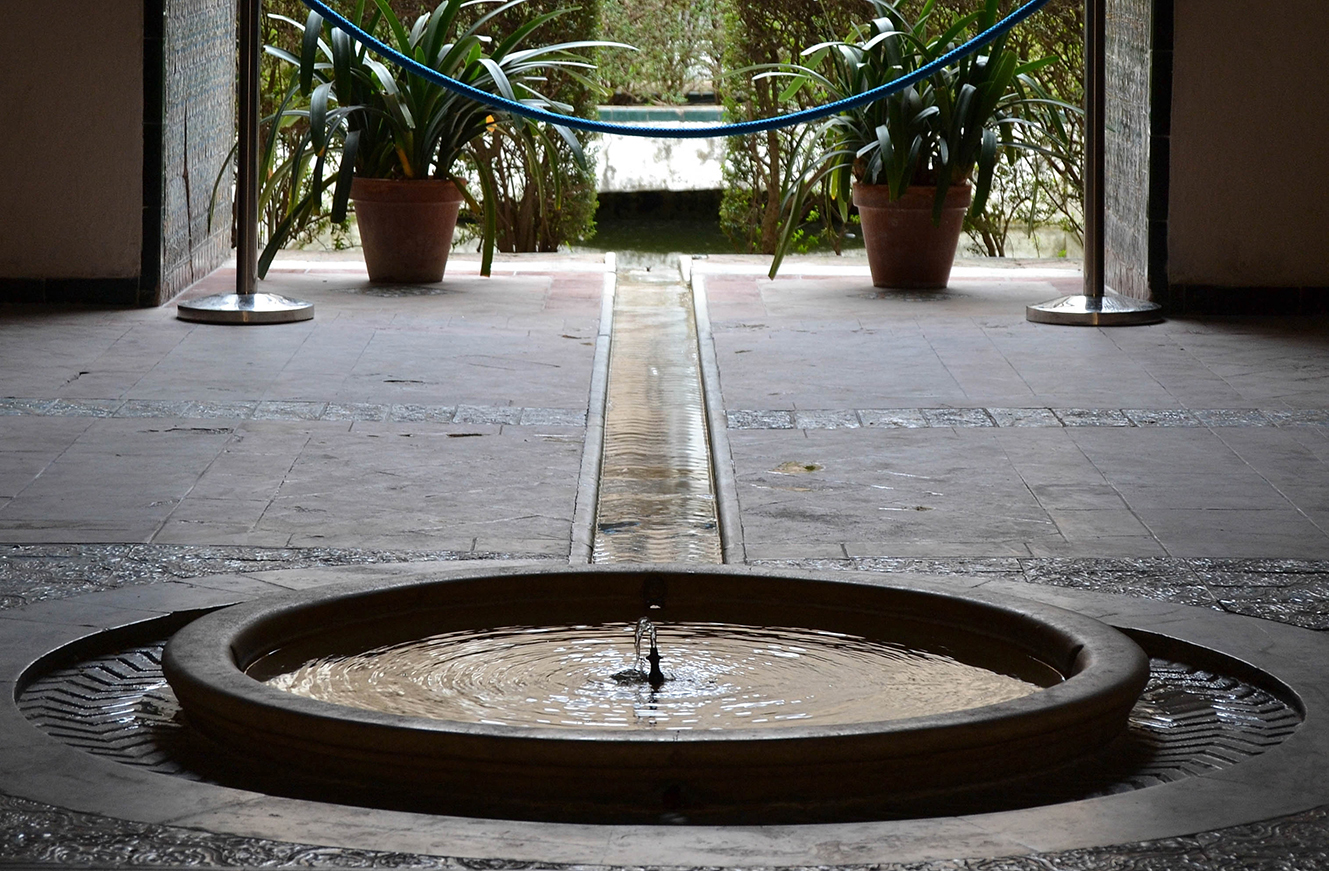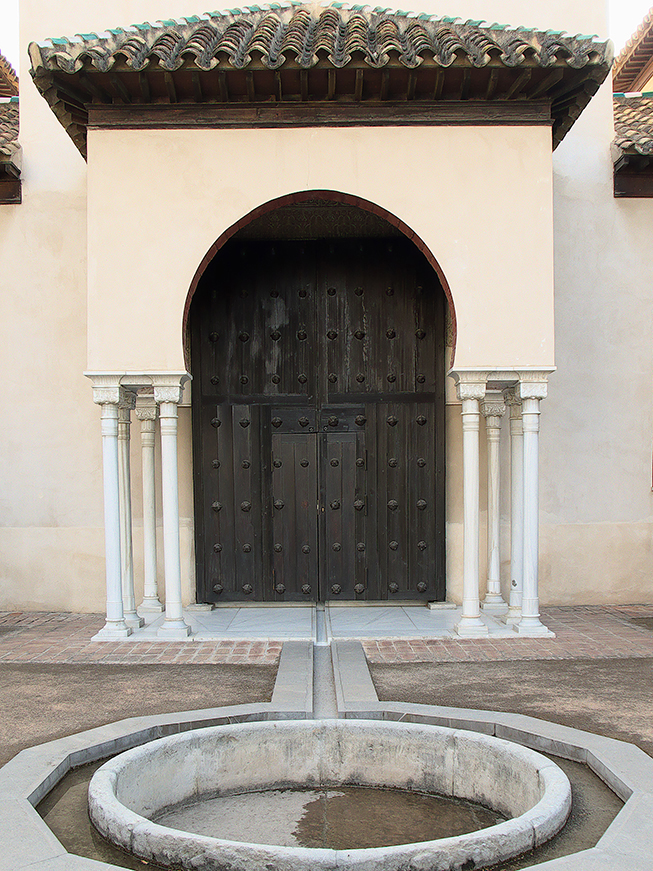Despite the importance of Samarra, the second capital of the Abbasid caliphate (132–656 AH/750–1258 CE), in the history of art and material culture of the Abbasid period in particular and of Islam in general, and despite the major excavations conducted in the city in the last century, its remains and material culture remain largely understudied. While Baghdad, the mythical Abbasid capital, almost completely vanished due to successive destructions and a continued occupation, Samarra, founded in 221 AH/836 CE, was abandoned in 279 AH/892 CE (except for the small part that occupies the same terrain as part of the modern city) and remained a large field of ruins that only began to be archaeologically explored at the turn of the twentieth century. The most significant excavations in the Abbasid city were undertaken by the German architect and archaeologist Ernst Herzfeld (1879–1948) in two campaigns, of 1911 and 1913.2 Earlier excavations had been undertaken by Henri Viollet in 1907–10,3 and later works were conducted by the Iraqi Directorate General of Antiquities (DGA) upon its establishment in 1936.4
Herzfeld’s finds were extensive. Even though the most important of them have been the object of a number of monographs in the series Die Ausgrabungen von Samarra,5 a final and detailed archaeological and architectural report that would have provided a firm context for their study and interpretation is lacking.6 In fact, only two preliminary reports were published, in 1912 and 1914 after the completion of the two campaigns.7 Herzfeld did, however, leave behind extensive written and pictorial documentation that is indispensable for a better understanding of the finds. These archives are currently held at several institutions in Europe and the United States, with the most significant at the archives of the National Museum of Asian Art within the Ernst Herzfeld Papers.8
Not only have the finds never been completely published to the appropriate standards, but the lack of access to the finds is a major obstacle to a proper evaluation of the city’s material remains. The items that were taken out of Iraq suffered from transport, wars, and poor conservation, and those that have survived are scattered in institutions in several countries. Due to the political situation, the items that have remained in Iraq are largely inaccessible, as is the site itself. As a result, our knowledge of the archaeological finds of the city is often inadequate or incomplete.
In this context, that of a poorly established architectural and archaeological framework (inaccessible finds and site, as well as unclear archaeological data), the present article attempts to contribute further understanding of one major, poorly documented find: a large stone basin clearly of ancient origin, in the Dār al-Khilāfa, the main palace of the Abbasid caliphs in Samarra. Facts concerning the discovery of this item in a square domed chamber with mural paintings, located off the throne hall of the palace, are unclear and even contradictory. This basin has sometimes been referred to as Qaṣʿat Firʿawn (Pharaoh’s Bowl), a large stone bowl mentioned in a number of medieval sources in Arabic and Persian as being part of the great fountain in the Great Mosque founded by al-Mutawakkil (r. 232–47 AH/847–61 CE) in Samarra.
The following study attempts to clarify the site and the conditions of the basin’s discovery, to examine the assumptions identifying it with Qaṣʿat Firʿawn, and to tackle the question of its origin in antiquity and how it was reused in the Abbasid period.
The Caliphal Palace’s Layout
The Caliphal Palace, or Dār al-Khilāfa, was the main palace of the Abbasid caliphs in Samarra, constructed in 221AH/836 CE by the caliph al-Muʿta ṣim (218–27AH/833–42 CE) during the foundation of the new capital (fig. 1).9 Dār al-Khilāfa maintained its prominence as the main site for official ceremonial and served intermittently as the caliph’s primary residence throughout the caliphal period of the city, until around 279 AH/892 CE when the capital was moved back to Baghdad. As the palace has only been partially excavated, understanding of its layout and function is incomplete. In addition to Herzfeld’s preliminary report,10 however, more recent works on its historical topography have provided an adequate and reliable interpretation.11
Built on the eastern bank of the river Tigris, the palace is a huge complex of several units. The core is laid out on a west–east axis and consists of a square building opening to the west onto the Tigris through a monumental triple-iwan entrance and to the east onto a large courtyard, the Great Esplanade. At the eastern end of the Great Esplanade is a sunken basin locally known as Hāwiyat al-Sibāʿ or Birkat al-Sibāʿ (the Small Serdāb, according to Herzfeld). To the north of this main axis, there are other architectural units and another palatial structure thought to be the residential part of the complex, al-Jawsaq al-Khāqāni.12
The square building is identified as the public reception area of the palace, known in the sources as Dār al-ʿĀmma, with its monumental entrance, Bāb al-ʿĀmma, at its western end (fig. 2). Passing through a succession of rooms and courtyards, this entrance leads to a complex meant for public audiences, with a cruciform throne room at its eastern end. South of the throne room and beyond a courtyard lies the square domed chamber mentioned above, surrounded by a corridor-like space open on all four sides with large entrances: to the north opening onto the courtyard, to the west onto a basilical room, and to the east and south onto structures that seem to have been frequently rebuilt (fig. 3). Herzfeld labeled this area as the palace’s harem, but this identification is highly questionable considering the close proximity of this space to the throne room, connected to it by a small courtyard on the northern side of the square domed chamber.13
Discovery and Description of the Hemispherical Basin
The present investigation arises from research involving the reassessment of the mural paintings uncovered by Herzfeld at Dār al-Khilāfa. The majority of these murals were found in the area situated to the south of the cruciform throne hall in particular in the square domed chamber (fig. 2).14 Herzfeld’s reports on the excavations of Dār al-Khilāfa are contradictory and rather vague concerning the existence of a large circular basin at the center of this space. In fact, the written records of the excavation do not mention this basin. It only appears in a few drawings and photographs, which led to the present investigation regarding the object’s discovery, including close examination of the available data left by Herzfeld and the DGA along with other pieces of textual evidence.
The Appearance of the Basin According to the Herzfeld Papers
Two plans archived with Herzfeld’s drawings and maps relate to his excavation of the Caliphal Palace and show a circular basin at the center of the square domed chamber of the so-called harem (figs. 3, 4). Its geometric characteristics are provided in a plate containing section drawings with the title “Samarra Jawsaq” (Jawsaq here is understood as referring to Dār al Khilāfa) (fig. 5).15 In addition, there are two photographic views of it in a hollow in the ground accompanied by the brief title “Dār al-Khilāfa” (figs. 6, 7).
It is worth noting here that anyone who has seen a photograph of the Madrasa al-Sharābiya in Baghdad (also known as the Abbasid Palace)16 after its restoration in the 1940s—figures 8 and 9—would have noted that the basin in its courtyard is the same as that in figures 3 and 5.17 In the Madrasa al-Sharābiya, the basin sits on a low cylindrical podium encircled by a ring-shaped base featuring a wavy groove along its top surface. Prior to being installed in the Madrasa al-Sharābiya, this ensemble (basin, podium, and ring-shaped base) had been placed in the Khān Murjān18 in Baghdad when the building was restored as the premises for the Museum of Arab Antiquities, inaugurated in 1937. A photograph of the basin features in the museum’s 1938 guide published by the DGA (fig. 10).19
Returning to Herzfeld’s papers, contrary to the pictorial documentation, the written records of the 1911–13 excavation campaign in Samarra are strangely silent on the subject of the basin, which given its size (3 meters in diameter as indicated in fig. 5) was hardly a minor discovery. In fact, there is no mention of it, either in the Fundjournal (find journal)20 or in the diary of the excavation (Tagebuch).21 While the report on the excavation at Dār al-Khilāfa published in 1914 notes a number of hemispherical basins found in various places in the palace, the basin described as being under the dome, at the center of the square domed chamber, is noted as quadrangular, not hemispherical.22 A sketch of the domed chamber drawn by Herzfeld in the last entry of the Tagebuch, dated June 16, 1913, shows a quadrangular basin (fig. 11). The account of the mural paintings published in 1927 includes a description of the square domed chamber (it was in this room that most of the paintings were discovered), indicating once more the existence of a quadrangular basin under the dome; and no mention is made of any other basin in this location.23
The information available online concerning the two photographs of this basin (figs. 6, 7) reveals that they are two glass negatives dating to 1930.24 The rest of the photos related to the excavations of Dār al-Khilāfa date, however, to 1911–13, when the two German excavation campaigns of Samara were undertaken. It turns out that Herzfeld returned to Samarra in 1930 to investigate the pottery of a neolithic cemetery to the south of the Dār al-Khilāfa,25 but given the brevity of his stay (from September 29 to October 10), it is unlikely that he would have had the time to undertake further excavations on the Abbasid site. In a small diary dated 1930, however, Herzfeld briefly recorded this last visit to Samarra and mentioned that, before starting the excavation at the Neolithic site, he had visited the Abbasid remains, and as he walked through the ruins, he spotted the Pharaoh’s Bowl in the harem: “d. (=die) Kasa i Firaun in Harem gesehen” (spotted the Kasa i Firaun in the harem).26 In all likelihood, by “Kasa i Firaun” Herzfeld meant the stone basin under discussion, which means that he was at the origin of the identification of this basin with the Pharaoh’s bowl of the medieval sources. Most importantly, this seems to be the first time the basin is explicitly recorded in writing, but Herzfeld uses the passive form to record this event, implying that the basin was already there within sight before he arrived.27
Moreover, in a letter addressed to Friedrich Sarre sent from Baghdad on October 10, 1930, Herzfeld mentions the recent discovery of a basin in syenite in the domed chamber of the Caliphal Palace.28 This statement seems to confirm that it was during his 1930 visit to Samarra that he noted the basin for the first time: “Ich wollte Ihnen nur von Samarra aus Grüße senden. Ich war 14 Tage da u. habe 12 Tage gegraben. . . . Neuerdings hat man im Harem des Palastes ein großes Syenitbecken gefunden, ein Springbrunnen im Kuppelraum mit den Malereien. Ich habe es aufgenommen” (I just wanted to send you greetings from Samarra. I was there for 14 days and excavated for 12 days. Recently, a large syenite basin was found in the harem of the palace, a fountain in the domed chamber with the paintings. I have recorded it).29 The phrase “hat man … gefunden” (one has … found) is also elusive. The actual conditions under which the basin was discovered are not clearly stated, and the person(s) who discovered it are not named.
Herzfeld also kept a sketchbook in 1930 titled “Miscellaneous Prehistoric Objects,” in which he recorded ancient objects from Iraq and Iran, probably during the travels and excavation works that he undertook that year.30 This documentation also contains further drawings of the basin in question (figs. 12, 13), including a cross-section with information on dimensions; two drawings of the two blocks of the ring-shaped base, which is currently to be seen with the basin in the Madrasa al-Sharabiya (figs. 8, 9); and a sketch of the square chamber at the center of which the basin appears surrounded by the ring-shaped base (figs. 12, 13). The notes accompanying these drawings indicate “Djawsaq al-Khāqānī” as the place of origin.31 These data from 1930 indicate that the basin was in all likelihood not discovered during the excavations of 1911–13 but much later, probably in 1930 or perhaps just a little earlier. The absence of any mention of the basin in the written documentation of the pre–World War I excavations and other documents produced before 1930 is thus resolved, but there remains the complex problem of where, exactly, the basin was discovered.
The records of 1930, in particular the tone of the letter addressed to Sarre, are clear: the stone basin was discovered “recently” in the “harem” of the Caliphal Palace, in the domed chamber with the mural paintings. The plans in figures 3 and 4, along with the information provided in the sketchbook of 1930, are in agreement with the written records of that same year. The photograph taken of this domed chamber during the 1913 excavations, however, shows a large empty hollow at the center (fig. 14). Where then might the basin have been found in 1930 if it was in the same chamber? The basin also appears in a large hollow in the two photographs dated 1930 (figs. 6, 7). If this hollow was dug in a layer deeper than the bottom of the depression that appears in the photograph of 1913 (fig. 14), then the plans in figures 3, 4, and 13 are not credible. If the basin had been found at a greater depth in 1930, this means that it does not date back to the same period as the walls of the square domed chamber but rather to an earlier period—which is unlikely to be the case.
The handwritten note accompanying the drawings of the two blocks of the annular base (fig. 13) indicates that these two pieces were found in “[the] bathhouse in Samarra.” The text runs as follow:
“Im Bad in Samarra, rotgelblicher, heller Marmor. Um das Syenit-Becken herum, Harem d. (=des) Djausaq al-Khaqani”
In the bath in Samarra, yellowish red, light/bright marble, around the syenite basin, Harem of Djausaq al-Khaqani.
Thus, the basin and the annular blocks were not in fact found in the same place. The former was found in the area of the Caliphal Palace, which Herzfeld designated as the harem, while the annular pieces were found in a bath about which we know very little (the bath according to the notes in the sketchbook). It is unclear whether this bath was inside or outside the palace complex.32 In the absence of further details explaining the rationale behind Herzfeld’s reconstruction in his drawings of the basin and its encircling by the annular base, it is justifiable to question the correctness of such a reconstruction. Furthermore, the exact site of the discovery of the basin and the annular blocks remains unresolved.
Reports of the Directorate General of Antiquities
The reports of the DGA for the years 1938 and 1940 contain very brief indications on the discovery of the basin in the Caliphal Palace at Samarra, but no precise information regarding the exact site of its find, the context, or the excavations during which this discovery was made.
In 1938, the Guide to the Arab Museum at Khān Murjān features a photograph of the basin in the hall of the museum (fig. 10), mentioning that it had been brought from the Dār al-Khalīfa in Samarra, that the cylindrical pedestal supporting it had been brought from al-Quwayr33 (the site of the palace al-Hārūnī),34 and that the stone blocks forming the ring-shaped base had been brought from different houses in Samarra.35
The report on excavations undertaken by the DGA in Samarra between 1936 and 1939 indicates, in a vague and terse way, that a large porphyry basin was found in Dār al-Khilāfa.36 The lack of clarity is remarkable. The basin is described as being carved out of porphyry in the Arabic text and of granite in the English text.37 (The Guide to the Arab Museum at Khān Murjān, mentioned above, describes it as being made of silex.38) In the section on stone finds, this report (on the Iraqi excavations of the 1930s) also lists the cylindrical base on which the basin has stood since being moved to Baghdad, indicating that this piece was found at al-Quwayr (Palace of al-Hārūnī).39 Another publication by the DGA on the city of Samarra gives the same information with similar brevity.40
In conclusion, Herzfeld’s documents and the DGA’s publications indicate that the basin, the support, and the blocks of the annular base were not in fact discovered in the same place. The basin was apparently found in the Dār al-Khilāfa around 1930 under unknown circumstances, and the cylindrical base in the Palace of al-Hārūnī during the excavations undertaken by the DGA in 1936 or 1937 at the latest.41 As for the blocks of the ring-shaped base, two were found in the bath around the same time as the basin was discovered, while the remaining pieces were found in different houses in Samarra during the DGA’s excavations of 1936 to 1938.42
Dhabīḥullāh al-Maḥallātī’s Account
The Iranian cleric Dhabīḥullāh al-Maḥallātī settled in Samarra in 1922. He was to live in the city for twenty-five years, leaving a work on its history featuring a succinct account of the basin:
كُنتُ ممّن حضر حين إخراج الحوض [الحوض الكبير المعروف في دار الآثار العربيّة ببغداد] من تحت الأنقاض فكان موضوعا في
قبلة بركة السباع43
I was among the people who were present at its [the large, well-known basin in the Museum of Arab Antiquities in Baghdad] extraction from under the rubble and it was placed in [the direction] of the Qibla of Birkat-al-Sibāʿ.
In all likelihood, the removal of the basin from the rubble, as described in this account, must have taken place during the DGA’s work of clearing and consolidating the archaeological site of Samarra beginning in 1936. As the basin is to be seen in the 1938 photograph of the entrance hall of the Khān Murjān in Baghdad (fig. 10), Maḥallātī’s account must date from between 1936, when the DGA was established, and 1938. As for Birkat al-Sibāʿ (Basin of the Lions), this is probably the building better known as Hāwiyat al-Ṣibāʿ (Lions’ Den) or the Small Serdāb (to use Herzfeld’s term): a square structure dug more deeply into the conglomerate and located to the east of the palace complex (fig. 1).44 The statement that the basin was placed “in [the direction] of the Qibla of Birkat-al-Sibāʿ” indicates that it was placed south of this building, and the location could be anywhere to the south of the building.
It is not clear whether the expression “فكان موضوعا في قبلة بركة السباع” (it was placed in [the direction] of the Qibla of Birkat-al-Sibāʿ) is simply poor phrasing due to a certain weakness in Maḥallātī’s Arabic, or whether the expression was used on purpose to indicate that the basin had not been removed from under the rubble of the site where it had been found, but in fact was at another site, where it had been “placed” after its discovery.45 If so, due to the size of the basin and, no doubt, its weight, moving it would have been extremely difficult. It is more likely that the basin had been raised up at the place where it had been found. In any case, Maḥallātī’s account concerning the location of the basin seems to be in accordance with Herzfeld’s brief indication in his 1930 diary: in fact, what Herzfeld had termed the harem of the palace is situated to the south of Birkat-al-Sibāʿ. Nonetheless, there is nothing to indicate that the basin was specifically found in the square domed chamber off the throne room, as appears in Herfzfeld’s drawings.
Some Conclusions Regarding the Findspot of the Basin
It thus emerges that the circumstances under which the basin was discovered are not entirely clear. Even if Herzfeld’s drawings and correspondence from 1930 assert the discovery of this basin in the square room of the so-called harem of the Dār al-Khilāfa, the photograph of this room taken in 1913 in no way confirms this as a possibility, since a great hollow appears at its center, making the discovery of such a large basin at this site in 1930 inconceivable. The reasons behind Herzfeld’s assertion that it had been found in that room are unclear. While the basin seems to have been found somewhere in the southern section of Dār al-Khilāfa, to the best of our knowledge there is no other source of information that might provide more precision regarding its original location. The basin might have been discovered by chance and left undocumented, possibly during illegal excavations sometime between 1923 (when Herzfeld revisited Samarra on his way to Iran) and 1930 (his last visit to the site, during which he first noticed the basin).46
Even if the results of the present investigation remain only partially conclusive, they do refute the general claim that the basin was found in the square domed chamber off the throne room of the palace. At the very least, such verification avoids erroneous interpretations that may be made regarding the basin itself and the site of its supposed discovery. With its huge size and seemingly antique origin, this vat was probably far from being a meaningless object, and this was perhaps one of the reasons behind its identification with the Pharaoh’s Bowl mentioned in the texts.
Was the Basin the Pharaoh’s Bowl?
As indicated earlier, certain studies have suggested that this basin is in fact Qaṣʿat Firʿawn, mentioned in some medieval sources in Arabic and Persian. This opinion was first expressed by Herzfeld in his brief notes of 1930.47 It was also the opinion of some Iraqi archaeologists such as Ṭāhir Muẓaffar al-ʿAmīd and English-language scholars such as Yasser Tabbaa and Alastair Northedge.48 Other Iraqi scholars have, however, disputed this opinion,49 and Herzfeld himself seems to have later abandoned this identification.50
Qaṣʿat Firʿawn was, according to the sources, a huge vat carved in stone that al-Mutawakkil had brought from al-Hārūni, his main residential palace, and placed in the fountain of his newly completed Great Mosque in Samarra in 237 AH/851–52 CE. The identification of the bowl of 1930 with Qaṣʿat Firʿawn is mainly based on the following texts, particularly the third, that of Mustawfi Qazwini (d. 750 AH/1349 CE):
He [al-Mutawakkil] made it [the Great Mosque at Samarra] firm and broad, and made its construction solid, and established in it a fountain of water, so that its water should not be cut off.51
In this year [237 AH/851–52 CE] the construction of the mosque of Samarra was completed. . . . The bowl and stones that are in the fountain were brought from Bāb al-Ḥarra in al-Hārūnī rapidly, brought by the three elephants which belonged to al-Mutawakkil. He spent 1,500 dīnārs on the transport up to the entry into the mosque, and if it had not been for the elephants, he would have spent twice that.52
Further he [al-Muʿtassim (sic)]53 built the Friday Mosque in Samarrah and set in the midst of its court a basin formed of one block of stone, this basin measuring 23 ells [gaz] in circumference with a height of 7 ells [gaz] and it was half an ell [gaz] in thickness. This basin was known as Pharaoh’s Cup and in all the country round for more than thirty leagues distance, there is no such a block of stone found.54
Ṭāhir Muẓaffar al-ʿAmīd does not seem to have been aware of the discovery of the basin in Samarra in the twentieth century, and seems to have only known of it in its current location in the Madrasa al-Sharābiya in Baghdad. His identification of the basin with Qaṣʿat Firʿawn is also based on a text by al-Ghassānī, dating to the late eighth AH/fourteenth century, stating that Qaṣʿat Firʿawn was brought from Samarra to Baghdad in 653 AH/1255 CE:55
وفيه [عام 653 ] وصل إلى بغداد حجر مجوّف على شكل البرك سعة قطرها سبعة أذرع كان في جامع سامرّاء، ويعرف بقصعة
فرعون وكان وصوله على العجل من سامرّاء إلى بغداد ومسافة ما بين جامع سامرّاء ودجلة خمسة عشر ألف ذراع فتركت على
دجلة تحت التاج بالقرب من باب البشرى.56
In this year [653 AH/1255 CE], there arrived in Baghdad a concave stone in the form of a basin, with a diameter of seven cubits. It was in the mosque at Samarra and was known as the Qaṣʿat Firʿawn. Its arrival in Baghdad from Samarra was rushed and as the distance from the mosque in Samarra and the Tigris is fifteen thousand cubits, it was left on the Tigris below al-Tāj near Bāb al-Bushrā.57
The text of Mustawfi Qazwini is the main source on which the identification of the Samarra bowl with Qaṣʿat Firʿawn is based, and his account describes Qaṣʿat Firʿawn as having been a great vat carved out of a single block of stone measuring 23 gaz in diameter and 7 gaz in height, and having a thickness of half a gaz.58 The gaz, a Persian unit of measurement used in Mustawfi Qazwini’s original text, was translated into English as cubit or ell. Although it is known that the actual value of the gaz varied according to geographic and historical contexts, it was in common use during the medieval Islamic period, corresponding to the Arab cubit and in particular to the legal cubit (al-dẖirāʿ al-sharʿiya), equivalent to 49.8 centimeters.59 Northedge considers that Mustawfi Qazwini, when translating this text from an Abbasid source, must have simply replaced dẖirāʿ by gaz. In this case, the cubit in general use during the Abbasid period—and at Samarra in particular—was the so-called black cubit or al-dẖirāʿ al-sawdāʾ, which Northedge estimates at 52.6 centimeters.60 Even though Herzfeld estimates the black cubit at 51.8 centimeters in his report of the 1911 excavations, he seems to have reached an estimate close to that of Northedge or even identical.61
On the basis of Mustawfi Qazwini’s text and the two possible values of the cubit (the legal cubit of 49.8 centimeters and the black cubit of 52.6 centimeters), the measurements for Qaṣʿat Firʿawn in meters are as in Table 1. The first remark that needs to be made is that the measurements of 3.48 and 3.68 meters given for the height of the basin are unlikely for a fountain bowl. It may be that there was a textual error and that the 7 gaz/cubits represent a rough figure for the diameter of the basin, which would have been about 7.32 gaz/cubits for a circumference equal to 23 gaz/cubits. Moreover, the text by al-Ghassānī mentions that the Qaṣʿat Firʿawn had a diameter of 7 cubits.
The two drawings by Herzfeld of the basin of Samarra indicate that the latter had a diameter of 300 centimeters (3 meters) and was 22.5 centimeters (0.225 meters) thick at the bottom. At the risk of a high degree of approximation, these measurements could be considered as close to those mentioned in Mustawfi Qazwini’s text. Erring on the side of caution with respect to the difference in the diameter’s measurements (0.64 and 0.85 centimeters), it is not possible to affirm that the Samarra basin was actually the Qaṣʿat Firʿawn.62
|
Circumference |
Height |
Thickness |
Deduced diameter |
|---|---|---|---|---|
In gaz (translated into cubits) |
23 |
7 |
0.5 |
7.32 |
In meters (on the basis of the legal cubit) |
11.45 |
3.48 |
0.249 |
3.64 |
In meters (on the basis of the black cubit) |
12.1 |
3.68 |
0.263 |
3.85 |
Moreover, looking closely again at Qazwini’s text, it appears from the following phrase that the height of the minaret (al-Malwiya) of the Great Mosque in Samarra was estimated at 170 gaz.63 translated into English as 170 ell.64 The Malwiya is 50 meters in height (52 meters including the base),65 which means that the gaz, the unit of measurement used in Mustawfi Qazwini’s text, is of the order of 30.5 centimeters, and the measurement is the foot rather than the cubit.66 The Arab sources indicate that the Malwiya is 99 cubits in height, not 170.67 Recalculating the dimensions of Qaṣʿat Firʿawn in meters and taking into account that what Mustawfi Qazwini means by gaz is foot and not ell, the basin’s diameter would be 2.23 meters and its thickness 0.15 meter, dimensions that do not correspond at all to the measurements of the Samarra basin.
The possibility of an error in Mustawfi Qazwini’s manuscript should not be excluded. The two units of measurement, the cubit and the foot, might both have been translated into gaz. The gaz in which the measurements of Qaṣʿat Firʿawn are given would thus correspond to the cubit (al-Ghassānī’s text also indicates that the diameter of the latter measures 7 cubits), whereas the gaz used to give the height of the Malwiya would correspond to a foot. In any case, this leads us to be circumspect with respect to Mustawfi Qazwini’s text, as it would seem to contain a number of mistakes, the first of these being the attribution of the construction of Samarra’s Great Mosque and its minaret to the caliph al-Muʿtaṣim rather than al-Mutawakkil.
Furthermore, the text by al-Ghassāni states clearly that the Qaṣʿat Firʿawn was moved in 653 AH/1256 CE from Samarra to Baghdad, where it was placed below the Palace al-Tāj.68 A further text from the fourteenth century gives the same facts, adding that the basin was broken four years later:69
“[سنة 653 ]: وفيها حملت القصعة الحجر المعروفة ب”قصعة فرعون” من سرّ من رأى إلى بغداد في كلك ورُفعت تحت دار
الخليفة، وكانت عظيمة جدّا فلم تزل إلى سنة سبع وخمسين وستمائة، ثم كسرت.”
In [653 AH/1256 CE] the stone bowl known as Qaṣʿat Firʿawn was transported from Surra Man Ra’ā to Baghdad in a kelek, it was installed below Dār al-Khalīfa (the Caliph’s Palace), it was enormous.
It continued to be there until 657 AH [259 CE] and then it was broken.70
This text has already been mentioned in modern works in relation to Qaṣʿat Firʿawn but without being given much credibility.71 There is, however, no real reason to discredit it, especially given that in the thirteenth century the Great Mosque of Samarra must have declined considerably in importance.72 Such a change in status would have justified the transfer of a major decorative item such as its unique fountain bowl to the Caliphal Palace in Baghdad.
To conclude, considering the information available regarding the basin discovered in Samarra along with that concerning Qas̤ʿat Firʿawn, it seems that the two should not be confused. The only argument in favor of the identification of these two basins with each other is that both were made out of a single block of stone. As mentioned earlier, Herzfeld in his posthumous work, Geschichte der Stadt Samarra (History of the city of Samarra), published in 1948, describes Qaṣʿat Firʿawn (kāsa i Fir’aun) as being “a large granite basin about twice as big as the one discovered in the Qabīḥa building [the square domed chamber]73 in the Jawsaq. The latter [that found in the Qabīḥa building] had been imported from Egypt and adapted for use as a fountain”: “Die kāsa i Fir’aun war ein großes Granitbecken, etwa doppelt so groß wie das im Bau der Qabīḥa im Djausaq ausgegrabene; dies ist aus Ägypten importiert und für einen Springbrunnen adaptiert.”74 This statement is quite confusing. First, it implies that Herzfeld found not one but two such basins: the basin that he had seen in the “harem” and that he identified as Qaṣʿat Firʿawn in his diary of 1930,75 and a second one, documented in his drawings, located in the Qabīḥa building (the square domed chamber, also located in the “harem”) and half the size of the first one. Second, this statement seems to be another assertion of the discovery of the stone basin in the domed chamber, which, as discussed above, is impossible considering the data available from the 1911–13 excavations. Therefore, the question that needs to be answered is whether, in fact, Herzfeld had found a second basin, and if so, why it was not recorded. Alternatively, he was simply not paying close attention as he wrote up this report—he could not have possibly known that the Qaṣʿat Firʿawn of the medieval texts was carved from granite.
Qaṣʿat Firʿawn and the Samarra Basin Actually Roman Labra
The resemblance between the Samarra basin and Roman vats called labra (sing. labrum) is striking: with slightly inward-curving sides, such large, shallow vats were likewise carved out of a single block of stone, often granite or marble; at the bottom there were generally two orifices, one in the center from which water sprang, and a second, off-centered draining hole. Sometimes the central orifice was situated in a protuberance (figs. 15, 17). Used to supply cold or warm water in the caldarium of Roman baths, these labra were generally placed on concrete bases, raising them to a level such that water could easily be scooped up by users. Water ran in them continuously, brought in by canals linked to the baths’ furnace.76 A large number of such labra have been found in bath complexes across the Roman territories. Some are enormous: The basin of Nero’s Domus Aurea (54–68 CE), with a diameter of 4.5 meters, was carved out of a single block of red porphyry.77 The labrum discovered in the baths of Alexander (or Nero) in Rome, cut out of a single block of Egyptian granite, has a diameter of 6 meters, and is currently to be seen in the Piazza Sant’ Eustachio in Rome, where it has been placed on a Renaissance cylindrical base and adapted as a fountain (fig. 16).78 Other labra of similar dimensions have been found in baths at sites as different as the Forum baths in Pompeii (fig. 17),79 the baths of Baelo Claudia at Cadiz in Spain (fig. 18),80 at Jerash in Jordan (reused in the Byzantine period in the city’s nymphaeum),81 and in Egypt.82 It seems likely that the basin discussed above was originally a Roman labrum recycled in Abbasid times.
It is also interesting to note that a large number of the labra from the Roman imperial baths and palaces are carved from Egyptian granite or imperial porphyry.83 This particular stone was considered highly desirable in imperial Roman buildings due to its solidity, the smooth finish it could be given, and its remarkable purple hue. Symbol of authority, porphyry came to be restricted to imperial usage from the first century CE until roughly the fifth century CE.84 The only quarries for imperial porphyry known from this period are situated in Egypt, in the eastern desert to the west of al-Ghardaqa (Hurghada). These quarries seem to have fallen out of use sometime in the fifth century CE. From that time forward the use of porphyry was limited to circulating already existing objects carved out of this stone.85
It thus may be reasonably supposed that the Pharaoh’s Bowl mentioned in the sources was originally also a Roman labrum reused in Abbasid times as part of a fountain, carved as it was from either Egyptian granite or porphyry. The basin probably acquired its Arabic name, with its reference to Egypt’s rulers, due to the Egyptian origin of the stone and to its huge size.86 Moreover, the fact that Mustawfi Qazwini writes that, “in all the country round for more than thirty leagues distance, there is no such a block of stone found [referring to the stone from which the Qaṣʿat Firʿawn is made]”87 confirms the rarity of this rock. It cannot be excluded that the stone is imperial porphyry. It is highly possible that Qaṣʿat Firʿawn and the Samarra basin were brought to Iraq from a neighboring Roman site—for example, from Syria, Antolia, or Egypt—and that they were adapted for Samarra in the new imperial Abbasid context.88
It is also interesting to recall that, according to Ibn al-Jawzī’s account, Qaṣʿat Firʿawn was in al-Hārūnī’s palace before being removed to al-Mutawakkil’s new Great Mosque in 237 AH/851–52 CE.89 Al-Hārūnī was the principal residence of the caliph Hārūn al-Wāthiq (r. 227–32 AH/842–47 CE), and then that of his brother al-Mutawakkil (r. 232–47 AH/847–61 CE) for most of the latter’s reign.90 It would seem that the so-called Pharaoh’s Bowl must have had particular symbolic importance for the Abbasid caliphs, as confirmed by its subsequent transfer to al-Tāj palace in Baghdad.
The reuse of architectural spolia and the borrowing and reformulation of elements of art vocabulary and symbols of sovereignty from earlier civilizations is a well-recognized phenomenon in Islam, particularly during its early centuries.91 In the imperial Abbasid context, Qaṣʿat Firʿawn and the reuse of Roman labra in general attest to a continued relevance of ancient Roman culture to the Abbasids. This is remarkable in two respects. First, the Abbasid period is generally viewed as a time marked by a decline in Mediterranean influence as the cultures of Iran and regions further east gained ground. This is to be seen in many areas, including the empire’s administration, the symbolic expression of power, and visual culture, due in particular to the transfer of the caliphate’s center of gravity from Syria to Iraq.92 Second, while the visual culture of the Umayyad caliphate was heavily influenced by Byzantium, or at the very least by late Roman culture, the example of Qaṣʿat Firʿawn can be seen as demonstrating a certain fascination of the Abbasids with ancient Rome, despite the fact that its power center, Baghdad, was well beyond the frontiers of the ancient Roman territories. It is not clear whether this appropriation of ancient Roman symbolic artifacts should be interpreted as being on the margins of the great intellectual and scientific movement that reached its height in the Abbasid period, and for which the classical Mediterranean heritage was of great importance, or as simply in line with the Abbasid caliphs’ efforts to appropriate and adapt the symbols of royal splendor of the great (and “competing”) civilizations of the past.
On another level one might wonder why Qaṣʿat Firʿawn, probably an antique Roman labrum, was attributed to a pharaoh. As suggested earlier, this might be explained by the provenance of the stone from which Qaṣʿat Firʿawn might have been carved (imperial porphyry or Egyptian granite) or to the provenance of the labrum itself (had it been brought from Egypt). The attribution to a pharaoh could also very likely be due simply to the antique origin of the basin and its huge size; in fact, there is evidence in the textual and vernacular traditions from the Islamic period of extremely large ancient objects or structures being attributed to pharaohs. For example, al-Tabari relates that during the construction of the round city of Baghdad, al-Mansūr had brought from Syria a gate of pharaonic fabrication that he had set up at the outside gate of the Bāb Khurāssan, one of the entrance points to the city,93 and it is reasonable to speculate that the dimensions of this portal must have been particularly large. Moreover, the Gadara aqueduct, a 170-kilometer-long system of Roman canals running between present-day Jordan and Syria, built between the first and second centuries CE, is ordinarily referred to as Qanāt Firʿūn (Pharaoh’s Tunnel). This tunnel system is held to be the longest and most sophisticated of the Roman canal systems ever discovered.94
In the Arab and Islamic collective imaginary up until today, pharaoh is a generic name for the ancient Egyptian rulers, without distinction between the different sovereigns (in the Quran, Pharaoh appears in connection to Moses and to Joseph).95 The pharaoh is seen as an all-powerful, conceited, and megalomanic king who challenged God’s rule, and his name is associated with mighty power, authoritative rule, vainglory, and enormous wealth. As such, it is reasonable that large antique objects or impressive enterprises for which no precise origin was known were attributed to “Pharaoh,” regardless of whether or not they were Egyptian.96
Repurposing During the Abbasid Period
To return now to the basin discovered in Samarra, it is highly likely that the base on which it is currently placed in the Madrasa al-Sharābiya (and that was discovered by the DGA in the Palace of al-Hārūnī; fig. 1)97 is the base that supported the Qaṣʿat Firʿawn when it was in that palace before its transfer to al-Mutawakkil’s Great Mosque.98 A possible example of such an assemblage is the labrum transformed into a fountain on the Piazza Sant’ Eustachio in Rome mentioned earlier (fig. 16).
It is not known exactly how the Qaṣʿat Firʿawn was set up in the fountain in the Great Mosque of Samarra and later in the al-Tāj Palace in Baghdad. However, according to Herzfeld’s discovery of the fountain’s site in the Great Mosque, it would seem that Qaṣʿat Firʿawn was set within a cylindrical basin made out of bricks covered with a particularly waterproof type of mortar laid with marble. It also appears that, above the whole fountain ensemble, there was a kiosk with marble columns topped by a wooden roof decorated with mosaics and paintings.99 It is highly probable that the basin discovered in 1930 was reused to put together a new fountain, particularly considering the two grooves (four according to Herzfeld)100 carved into the edge in order to facilitate the flow of water (figs. 6, 7).101 If the restitution suggested by Herzfeld in his diagrams (figs. 3, 5, 13) is correct—that is, if the basin was actually inserted in the annular base—it would seem that what he described is an original type of low fountain equipped with a sophisticated and refined water-circulation system.
Before moving on to present the possible operating schemes of this system, it should be noted that a comparison of the photograph of the Samarra basin when it was in the Khān Murjān in 1937–38 (fig. 10) with Herzfeld’s plans (figs. 3, 5, 13) and the recent photographs of the Madrasa al-Sharābiya (figs. 8, 9) reveals an interesting difference: while in Herzfeld’s plan and the recent photographs the annular base is whole and independent, in the Khān Murjān photograph it appears linked to a longitudinal conduit, probably a surface channel. Such a conduit does not feature in Herzfeld’s drawings; he had discovered just two blocks of the annular base, as is clearly seen in his 1930 sketch (fig. 13), and thus he completed his drawing of the fountain as he imagined it to have been. The remaining blocks as well as the pieces constituting the conduit were most probably found by the DGA in 1936.102
Moreover, at the present time, in all likelihood out of convenience, the conduit no longer forms part of the fountain in the Madrasa al-Sharābiya. The annular base may have been entirely replaced by a similar new base or even just restored, with the two blocks attached on either side of the conduit being replaced by two other blocks without a conduit. In addition, the longitudinal conduit of the basin in Khān Murjān (fig. 10) can be seen to be composed of two parallel channels. The one on the right nearest the viewer appears to be continuous with the undulating groove in the annular base. Even if this is not very clear, the left-hand channel also seems continuous with the groove in the other side. In addition, there is a hole at the junction of the left-hand conduit and the annular base. Thus, the water circulation system in the fountain may have worked in one of two ways: The hole may have supplied water to the fountain, that is, the water entered from a given source through the left-hand channel of the conduit and flowed via this hole into an underground conduit that supplied the fountain; the water then sprang up into the fountain from the hole at the center of the basin. Given that the basin was shallow, the water would quickly be at a level at which it overflowed via the two opposing grooves on the edge (visible in figs. 6 and 7) onto the surface of the annular base, where it collected in the wavy groove and then flowed via the second channel in the direction from which it had come. This possibility presupposes that the fountain’s water was flowing in a closed circuit: water arrived via one of the two channels of the conduit and was subsequently taken away to its point of origin along the second parallel channel.
Otherwise, the hole might have served to empty the fountain. It would have been blocked when the fountain was operational, and then unblocked when the fountain was closed in order to drain the water. In this case, it is possible to imagine the existence of an underground conduit supplying water to the fountain. The water would have sprung into the basin via the orifice at its center before flowing out through the two grooves on the edge toward the surface of the annular base, where it would have collected in the wavy groove and through which it would have continued to flow in two directions, arriving simultaneously in the two parallel channels of the longitudinal conduit before flowing away to an unknown point.
These suppositions are highly hypothetical given the lack of actual dimensions for the annular base. Herzfeld’s drawing is based solely on two blocks and does not provide any indication as to whether the internal curve of these blocks actually corresponds to the external curve of the basin (fig. 5). If this correspondence were to be verified, it might confirm that the basin and the annular base were part of the same fountain, but the fact that the basin and the blocks of the annular base were found in different places further complicates the puzzle. In fact, even the different blocks forming the annular base seem to have been found in different places: two were found, according to Herzfeld, in “the bath.” The remaining blocks were found elsewhere in Samarra in private houses, circumstances that could also indicate that these stones came from more than one fountain, and that this fountain type was widespread in the city.
If Herzfeld’s proposed restitution is correct, the basin could be seen as a unique and remarkable example of an engineer’s creativity in transforming a labrum from a Roman bath into a fountain equipped with a superb water-circulation system. This was achieved by carving two (or four) grooves into the edge of the labrum and adding the annular base with its wavy groove and the two-channel conduit into which the water flowed, possibly in a closed circuit.
While no exact parallels to this fountain have been identified, its general appearance is reminiscent of later examples from Muslim Spain, where water channels were often used to link two or more spaces in a single building. For example, water springing from a fountain in a closed space would be channeled along a narrow surface conduit to an open space, after which it would flow into a basin (or vice versa, springing from a fountain in an open space to run into a closed area). The most famous example of this is, of course, the fountain in the Court of the Lions in the Alhambra Palace in Granada. Other examples include the fountain of the Hall of Justice in the Alcázar of Seville and what has survived from the Alcázar Genil, also in Granada (figs. 19, 20). All these examples are fairly late, however, dating to the thirteenth and fourteenth centuries.
It is hoped that a closer study of the Samarra labrum/fountain currently at the Madrasa al-Sharābiya in Baghdad, along with further investigations of the archives of the Iraqi excavations (if they still exist), would allow verification of the suggested restitution. Along with other examples from northern Syria,103 the Samarra fountain could bear further witness to the influence of Iraqi hydraulic technology and the art of fountains on Muslim Spain as well as on other parts of the Islamic world.104
Conclusion
This article is an attempt to clarify the archaeological and architectural context of a poorly documented object from a key Abbasid site, namely the city of Samarra, and whether it might be identified with the so-called Qaṣʿat Firʿawn (Pharaoh’s Bowl)—an almost legendary object mentioned in the medieval sources as having been the gigantic stone basin situated in the fountain of al-Mutawakkil’s Great Mosque. To date it has commonly been held that this object, a large stone basin of ancient origin, was found in the square domed chamber with murals in the Caliphal Palace. Although the present contribution is only partially conclusive, it does refute the general claim that the basin was found at that location. Reading of the sources along with an analysis of some archaeological data suggests that this basin could not have been Pharaoh’s Bowl. Rather, it was probably a similar object, a Roman labrum adapted in Abbasid times, possibly as a component of a low fountain that seems to have functioned thanks to a unique, highly sophisticated water-circulation system recalling those created later in Muslim Spain.
Verification of the findspot and the identification with Qaṣʿat Firʿawn, at the very least, would avoid the basin’s continued association with its alleged place of discovery, the square domed chamber with the mural paintings. Considering its lavish murals and its proximity to the throne hall, this room may have had special importance, but given the intimate character of the themes depicted in its paintings, this importance was certainly limited to private use (at least during the lifetime of the murals).105 If one assumes that the large ancient labra, just as the legendary Qaṣʿat Firʿawn, were seen by the Abbasids as symbolic objects related to imperial power, then these basins would have been more likely to be installed in public areas of the palace. Verification that the Samarra labrum was not found in the square domed chamber could be taken as further confirmation of the private character of this space. Moreover, the existence of confusing information in the various early to mid-twentieth-century archaeological reports and archival documents could suggest that more than one such labrum and additional remains of an annular base or bases were found in Samarra. In that case, this type of low fountain, composed of a labrum set within an annular base, may have been used elsewhere in the Abbasid city.
Nevertheless, the obvious difficulties with respect to the in-situ study of ancient sites and objects in Iraq at the time of writing, along with limited access to the firsthand documents associated with them (especially those related to the Iraqi excavations), represent a major obstacle to research. Any attempt at reconstituting this type of low fountain depends upon the verification of certain details regarding the actual engineering techniques of such fountains and the hydraulic systems in use at Samarra in the ninth century CE. Actual work in the field could shed further light on Abbasid society’s capacities for assimilation and technological innovation during this period.
More broadly, this study demonstrates the importance of the detailed critical study of archaeological finds in Samarra using a range of sources. As the results of the German excavations have not been fully published, the Ernst Herzfeld Papers at the archives of the National Museum of Asian Art have proven to be of paramount importance for a proper evaluation of the finds. Revealing as it does certain specific aspects of Abbasid culture in Iraq, this contribution can be taken as suggesting the important potential for research in this area.
Acknowledgments
I would like to thank Jens Kröger and Alastair Northedge for answering various questions and sharing key documents related to Herzfeld’s excavations; Jennifer Berry and Xavier Courouble at the National Museum of Asian Art Archives, for answering my various questions and requests related to Herzfeld’s papers; Laura Hinrichsen and Linda Mueller for their help with deciphering Herzfeld’s handwriting; Justin McGuinness for kindly translating from French most of this text; and the anonymous reviewers for their comments.
Author Biography
Fatma Dahmani, PhD (University of Paris I Panthéon-Sorbonne), is Assistant Professor of Islamic Art and Architecture at the University of Qayrawan (Kairouan) in Tunisia. She has been working on a reassessment of finds, particularly paintings, uncovered at the Abbasid city of Samarra. E-mail: dahmani.fatma@gmail.com
Notes
- A different perspective on the issues discussed in the present article has been addressed in my earlier article “ʿAn al-Ḥawdh al-Ḥajarī bi al-Madrasa al-Sharābiya bi Baghdād: Iʿādat Nadhar fī Tārīkhihi wa fī Taʿrīfihi bi Qaṣʿat Firʿaoun,” Al-Abḥāth 69.1 (2021): 211–43. The present article contains additional data and updated information. ⮭
- Ernst Herzfeld, Erster vorläufiger Bericht über die Ausgrabungen von Samarra (Berlin: Dietrich Reimer, 1912); Ernst Herzfeld, “Mitteilung über die Arbeiten der zweiten Kampagne von Samarra,” Der Islam 5 (1914): 196–204. Regarding these excavations, see also Alastair Northedge, “Ernst Herzfeld, Samarra, and Islamic Archaeology,” in Ernst Herzfeld and the Development of Near Eastern Studies, 1900–1950, ed. Ann C. Gunter and Stefan R. Hauser (Boston: Brill, 2005), 385–400. ⮭
- See Henry Viollet, “Fouilles à Samara en Mésopotamie: Un palais musulman du IXe siècle,” in Mémoires présentés par divers savants à l’Académie des inscriptions et belles-lettres de l’Institut de France: Première série; Sujets divers d’érudition (1913), 12: pt. 2, 685–718; and Henry Viollet, “Description du palais de Al-Moutasim, fils d’Haroun-al-Raschid, à Samara, et quelques monuments arabes peu connus de la Mésopotamie,” in Mémoires présentés par divers savants (1913), 12: pt. 2, 567–69, 577–93. Regarding Viollet’s excavations, see also Northedge, “Ernst Herzfeld,” 385–86; and Vanessa Rose, “Les fouilles d’Henry Viollet à Samarra,” Annales islamologiques 51 (2017): 167–90. ⮭
- Directorate General of Antiquities (Iraq) (cited hereafter as DGA), Ḥafriyyāt Sāmarrāʾ, 1936–1939 (Excavations at Samarra, 1936–1939), 2 vols. (Baghdad: Government Press, 1940). For an overview of the Iraqi excavations in Samarra, see also Alastair Northedge, “Samarra Today: The Present Situation of the Site and Studies,” Beiträge zur Islamischen Kunst und Archäologie 4 (2014): 78–94. ⮭
- Ernst Herzfeld, Friedrich Sarre, and Carl J. Lamm, Forschungen zur Islamischen Kunst II: Die Ausgrabungen von Samarra, 6 vols. (Berlin: Dietrich Reimer; Hamburg: Eckardt & Mestorff, 1923–48). ⮭
- A final report has never been published due to several difficulties encountered by Herzfeld, including destruction of the remains and inaccessibility of some of the excavation’s material. See Freer Gallery of Art and Joseph M. Upton, Catalogue of the Herzfeld Archive: First Publication of Joseph M. Upton’s Catalogue of the Herzfeld Archive, Compiled in 1974 (Leiden: IDC, 2000), 7. ⮭
- A final report on the architecture of the buildings excavated during the first campaign was later prepared and published in 2003: Thomas Leisten, Excavation of Samarra (Mainz am Rhein: P. von Zabern, 2003). A final report has not been published on the Caliphal Palace, excavated during the second campaign. For an assessment of Herzfeld’s publication of his excavations in Samarra, see Northedge, “Ernst Herzfeld,” 392–94. ⮭
- Ernst Herzfeld Papers, National Museum of Asian Art Archives, Smithsonian Institution (cited hereafter as Herzfeld Papers), FSA.A.06, https://sova.si.edu/record/FSA.A.06?s=0&n=10&t=C&q=&i=0. ⮭
- Following Herzfeld, it has also come to be known as “al-Jawsaq” or “al-Jawsaq al-Khāqāni,” a term frequently mentioned in the medieval Arabic sources and that has been proven to refer only to the private part of the palace. See Alastair Northedge, “An Interpretation of the Palace of the Caliph at Samarra (Dar al-Khilafa or Jawsaq al-Khaqani),” Ars Orientalis 23 (1993): 143–52; and Alastair Northedge, The Historical Topgraphy of Samarra (London: British School of Archaeology in Iraq, 2005), 143. On the Caliphal Palace and its interpretation, see Northedge, “Interpretation,” 143–71; Northedge, Historical Topography, 133–50; and Ahmad Sūsa, Rayy Sāmārrāʾ fī ʿAhd al-Khilāfa al-ʿAbbāsiyya (The irrigation of Samarra during the Abbassid Caliphate) (Baghdad: Maṭbaʿat al-Maʿārif, 1948), 1:66–71. ⮭
- Herzfeld, “Mitteilung.” ⮭
- Northedge, “Interpretation”; and Northedge, Historical Topography, 133–50. ⮭
- Northedge, Historical Topography, 143. ⮭
- See Alastair Northedge, “Analyse du plan du palais du calife al-Mu`tasim à Samarra,” in Colloque International d’Archéologie Islamique, Cairo, 3–7 February 1993, ed. Roland Pierre Gayraud (Paris: Publications de l’IFAO, 1998), 154; and Fatma Dahmani, “A Reassessment of the Location of the Mural Paintings in the Caliphal Palace of Samarra,” Der Islam 97.2 (2020): 372. ⮭
- Dahmani, “Ressassement,” 95–106. ⮭
- Herzfeld understood Jawsaq (abbreviation for al-Jawsaq al-Khāqānī), a term used infrequently in the Arabic sources, as the same as Dār al-Khilāfa. He thus used the two words interchangeably to designate the same structure. However, it emerged that Jawsaq should only be used to designate the private part of the Caliphal Palace complex known as Dār al-Khilāfa, or Dār al-Khalīfa. On this question, see Northedge, “Interpretation,” 143, 152; and Northedge, Historical Topography, 143. ⮭
- For arguments in favor of its identification as a madrasa rather than a palace, see Directorate of Antiquities, Baqāyā al-Qaṣr al-ʿAbbāsī fī Qalʿat Baghdād (Remains of the Abbassid Palace in the Citadel of Baghdad) (Baghdad: Government Press, 1935); and Nājī Maʿrouf, Al-Madrasa al-Sharābiya Aw “al-Qaṣr al-ʿAbbāsī” fī Qalʿat Baghdād (The Madrasa al-Sharābiya or “The Abbasid Palace” in the Citadel of Baghdad) (Baghdad: Maṭbaʿat al-ʿĀnī, 1961). ⮭
- Regarding these restorations, see DGA, Some Notes on the Antiquities in the Abbasid Palace, 2nd ed. (Baghdad: Government Press, 1956), 1. ⮭
- مرجان: also spelled Marjān and Mirjān. ⮭
- DGA, Dalīl Matḥaf al-Āthār al-ʿArabiya fī Khān Murjān (Guide to the Museum of Arab Antiquities in Khān Murjān) (Baghdad: Government Press, 1938), 8; ʿAṭā al-Ḥadīthī, “Khān Murjān wa Ṣiyānatuhu” (Khān Murjān and its maintenance), Sumer 30 (1974): 167. There seems to be little doubt that this basin is the same as that appearing in Herzfeld’s documents, since his drawing D-1035 and this museum’s guide both indicate 3 meters as the basin’s diameters. ⮭
- The Fundjournal is a detailed list of the finds made during the two campaigns: Ernst Herzfeld Papers, S-1, Fundjournal (Finds Journal), National Museum of Asian Art Archives, Smithsonian Institution, https://sova.si.edu/details/FSA.A.06#ref10433. ⮭
- The Tagebuch is a detailed chronological account of excavations and discoveries, including the archaeologists’ first impressions and their preliminary interpretations. Ernst Herzfeld Papers, S-9, FSA A.06 07.09, Tagebuch Samarra 2te Campagne (Excavation of Samarra: Second Campaign, Diary 1, 1912-1913), National Museum of Asian Art Archives, https://sova.si.edu/details/FSA.A.06#ref10457. ⮭
- Herzfeld, “Mitteilung,” 200–201. ⮭
- Herzfeld, Die Malereien von Samarra (Berlin: Dietrich Reimer, 1927), viii. ⮭
- Herzfeld Papers, ser. 4: Photographic files, FSA A.6 04.GN.3190, https://sova.si.edu/details/FSA.A.06#ref28385; and FSA A.6 04.GN.3197, https://sova.si.edu/details/FSA.A.06#ref25374. ⮭
- Herzfeld Papers, ser. 3: Notebooks, N-57: Diary, 1930, FSA A.6 03.057; Jens Kröger, “Chronik der Ausgrabungen von Samarra, 1911–1913: Eine Kulturhistorische Studie zur Forschungs- und Förderungsgeschichte der Islamischen Archäologie im 20. Jahrhundert,” Beiträge zur Islamischen Kunst und Archäologie 4 (2014): 32; Ministry of Education (Iraq), Report on Excavations in ʿIraq During the Season 1928–29 (Baghdad: Government Press, 1933): 3, 6, 44. ⮭
- Herzfeld Papers, N-57: Diary, 1930, October 1. ⮭
- I thank Linda Mueller for clarifying this point. ⮭
- Friedrich Sarre was then director of the Islamic collections at the Kaiser Friedrich Museum in Berlin, and it is thanks to his efforts that the Samarra excavations took place. Syenite is a magmatic rock similar to granite, gray, purplish, or reddish in color. The rock’s name derives from Syene, the ancient name for the city of Assouan in Egypt. ⮭
- Ernst Herzfeld to Friedrich Sarre, October 10, 1930. I am very grateful to Dr. Jens Kröger for sending me a copy of this letter with a transcription and a translation. ⮭
- Herzfeld Papers, ser. 2: Sketchbooks, subser. 2.10: Miscellaneous prehistoric objects, sketchbook 25, FSA A.06 02.10.25, https://sova.si.edu/details/FSA.A.06#ref7658. I am grateful to Xavier Corouble for bringing this sketchbook to my attention. ⮭
- Herzfeld Papers, sketchbook 25, [§64–67]. ⮭
- There is a small square building, listed by Northedge as unit “H345,” located northwest of the square reception block (Dār al-ʿĀmma), and that has been described by John Ross as al-Hammam (the bath); it is possible that Herzfeld’s “[dem] Bad” refers to this building. See Northedge, “Palace of the Caliph,” 150–51; Alastair Northedge and Derek Kennet, Archaeological Atlas of Samarra, Samarra Studies 2.2 (London: British Institute for the Study of Iraq, 2015), 375; and John Ross, “A Journey from Baghdad to the Ruins of Opis and the Median Wall in 1834,” Journal of the Royal Geographic Society 11 (1841): 129. Furthermore, the square reception block or Dār al-ʿĀmma also has a bath between the entrance area and the throne room (fig. 2). It cannot be excluded, however, that there were baths in other parts of the palace complex. ⮭
- This guide also indicates that the cylindrical base found in al-Quwayr may have been the base of a similar basin. See DGA, Ḥafriyyāt Sāmarrāʾ, 1936–1939 (Excavations at Samarra, 1936–1939) (Baghdad: Government Press, 1940), 9, pl. CXXXVIII (English section). ⮭
- Built by the caliph Hārūn al-Wāthiq (227 AH/842 CE–232 AH/847 CE). On al-Hārūnī, see Northedge, Historical Topography, 227. ⮭
- DGA, Dalīl Matḥaf al-Āthār al-ʿArabiya fī Khān Murjān (Guide to the Museum of Arab Antiquities in Khān Murjān) (Baghdad: Government Press, 1938), 19, pls.7 and 13. ⮭
- DGA, Ḥafriyyāt, 2:14 (Arabic). ⮭
- DGA, Ḥafriyyāt, 2:14 (Arabic), 2:9 (English). ⮭
- DGA, Dalīl, 19. This discrepancy might indicate that more than one such basin was found, but others were left undocumented. ⮭
- DGA, Ḥafriyyāt, 2:13–14, pl. 133 (Arabic), 8–9 (English). ⮭
- DGA, Sāmarrāʾ (Baghdad: Government Press, 1940), 55, 69–70. ⮭
- The basin appears on this pedestal in a photo published in 1938 (DGA [1938], Dalīl, pls. 7, 13); the excavations of the DGA in Samarra began in 1936. ⮭
- The guide to the Museum of Arab Antiquities in Khān Murjān adds that the blocks that were found in a few private houses “were certainly taken to these houses from Dār al-Khalīfa” (DGA, Dalīl, 19), but the author does not explain how he came to such a conclusion. In my opinion, this could indicate that there were several similar ring-shaped bases, and that the blocks found in the private houses did not come from the same base as the blocks found by Herzfeld. One might speculate that there would have been a number of those annular bases in the Caliphal Palace as well as elsewhere in Samarra. ⮭
- Dhabīḥullāh al-Maḥallātī, Maʾāthir al-Kubarāʾ fī Tārīkh Sāmārrāʾ (Qom: al-Maktaba al-Ḥaydariya, 1964–65), 1:105–6. ⮭
- Northedge, “Palace of the Caliph,” 149; Northedge, Historical Topography, 135, fig. 57. ⮭
- Maḥallātīs poor mastery of the Arabic language can also be gauged from the phrase preceding his testimony, suggesting that he had not understood the indication given in DGA, Sāmarrāʾ, 69–70, which concerns the basin’s support and not the basin as a whole. See Mahallātī, Maʾāthir, 1:105–6. ⮭
- Herzfeld visited Samarra briefly on his way to Iran in 1923. During this visit he was able to note the extent to which the buildings that he had excavated ten years earlier had deteriorated. See Kröger, “Chronik,” 327. The report of the Ministry of Education documenting the various excavations carried out in Iraq between 1929 and 1932 mentions the spread of illegal excavations throughout the country. See Ministry of Education, Report, 10–11(Arabic), 6–7 (English). ⮭
- Herzfeld Papers, N-57: Diary, 1930, October 1. Furthermore, a photo album titled “Syrian Inscriptions” and dated to 1930 contains prints of the two photos of the basin with a handwritten note in Arabic that reads: كاسة فرعون (Kāsat Firʿawn). This album was likely prepared by Joseph Upton in the early 1970s following Herzfeld’s notes and indications, further suggesting that Herzfeld was the first to identify the basin with the Pharaoh’s Bowl. See Herzfeld Papers, ser. 5: Photographic files, no. 12: [§2]; and Upton, Catalogue of the Herzfeld Archive, 79. ⮭
- Ṭāhir Muẓaffar [al-ʿAmīd], “ʿImārat Sāmārrāʾ al-ʿAbbasiyya fī ʿAhd al-Mutawakkil” (The Abbsid architecture of Samarra during the reign of al-Mutawakkil), Sumer 32 (1976): 204 (Arabic); Yasser Tabbaa, “Towards an Interpretation of the Use of Water in Islamic Courtyards and Courtyard Gardens,” Studies in the History of Gardens and Designed Landscape 7.3 (1987): 199; Northedge, Historical Topography, 123. ⮭
- ʿAlāʾ al-Dīn Ahmad, “Istidrākāt Āthāriya,” Sumer 36 (1980): 365; Ahmad ʿAbd al-Bāqī, Sāmārrāʾ ʿāṣimat al-dawla al-ʿarabiya fī ʿahd al-ʿabbāsīyīn (Samarra, capital of the Arab state during the Abbassid era) (Beirut: Al-Dār al-ʿArabiya lil-Mawsūʿāt, 2007): 1:118–19. ⮭
- See below and Ernst Herzfeld, Geschichte der Stadt Samarra: Die Ausgrabungen von Samarra VI (Hamburg: Eckardt & Mestorff, 1948), 123–24. ⮭
- Al-Yaʿqūbī, Aḥmad b. Abī Yaʿqūb b. Wāḍiḥ, Kitāb al-Buldān (Leiden: Brill, 1892), 40; trans. Northedge, Historical Topography, 122. ⮭
- Abī al-Faḍl ʿAbd al-Raḥmān b. ʿAlī Ibn al-Jawzī, Al-Muntaẓam fī tārīkh al-Mulūk wa al-ʾ Umam, ed. Muhammad A. ʿAṭā and Mustafa A. ʿAṭā, rev. Naʿīm Zarzūr (Beirut: Dār al-Kutub al-ʿ Ilmiya, 1995), 11:273; trans. Northedge, Historical Topography, 122. ⮭
- This should refer to al-Mutawakkil not al-Muʿtasim. ⮭
- Ḥamdallāh Mustawfi Qazwini, The Geographical Part of the Nuzhat al-Qulub, ed. and trans. Guy Le Strange (Leyden: Brill; London: Luzac, 1919), 48–49. ⮭
- Muẓaffar [al-ʿAmīd], “ʿImārat Sāmārrāʾ,” 204–5. ⮭
- Al-Malik al-Ashraf al-Ghassānī, Al-ʿAsjad al-Masbūk wa-l-Jawhar al-Maḥkūk, ed. Chaker M. ʿAbd-al Munʿim (Baghdad: Dār al-Bayān; Beirut: Dār al-Turāth al-Islāmī, 1975), 610. ⮭
- I thank Mathias Hoorelbeke for clarifying the subtleties of this text. ⮭
- Ḥamdallah Mustawfi Qazwini, Nuzhat al-Qulūb, al-Maqāla al-Thālitha, ed. Guy Le Strange (Leiden: Brill, 1913), 42. ⮭
- “Misāḥa,” in Encyclopedia of Islam, Second Edition, ed. P. Bearman et al., accessed January 19, 2023, http://dx.doi.org/10.1163/1573-3912_islam_COM_0753; “Ḏẖirāʿ,” in Encyclopedia of Islam, Second Edition, accessed January 19, 2023, http://dx.doi.org/10.1163/1573-3912. ⮭
- Northedge, Historical Topography, 123n385; Alastair Northedge, “The Racecourses at Sāmarrāʾ,” Bulletin of the School of Oriental and African Studies 53.1 (1990): 54. ⮭
- Herzfeld, Erster Vorläufiger Bericht, 42–44. In the same report, Herzfeld gives a circumference of 23 cubits for the Qaṣʿat Firʿawn and a diameter of 3.90 meters. If we use black cubits of 51.8 centimeters, the diameter would be 3.79 meters. If we adopt cubits of 52.6 centimeters, as Northedge suggests, then the diameter would be 3.85 meters, which is closer to 3.90 meters. See Herzfeld, Erster Vorläufiger Bericht, 11. ⮭
- Northedge’s calculation (Historical Topography, 123) that led him to identify the Qaṣʿat Firʿawn with the Samarra basin is in fact wrong on two levels: First, he used a value of 26 cubits for the circumference while Mustawfi Qazwini gives just 23 cubits. Second, he gives a figure of 4.22 meters for the basin’s diameter, whereas Herzfeld’s drawings give 3 meters. That said, the figure of 4.22 meters is intriguing. As Northedge does not actually remember where he found this figure (personal communication with the author), it is possible that there may have been a second—but poorly documented—basin found in Samarra with a diameter of 4.22 meters. ⮭
- Mustawfi Qazwinī, Nuzhat al-Qulūb, al-Maqāla al-thālitha, 42. ⮭
- “Further he [al-Mu’tassim] [sic] built a minaret for the mosque, 170 ells in height with a ramp (to ascend it) on the outside, and no minaret after this fashion was ever built by any one before his time.” Qazwīnī, The Geographical Part of the Nuzhat al-Qulūb, 48, 49. ⮭
- DGA, Sāmārrāʾ, 44; Rabīʿ al-Qaysī, “al-Malwiya, Manārat al-Masjid al-Jāmiʿ fī Sāmārrāʾ” (al-Malwiya, minaret of the Great Mosque in Samarra), Sumer 26 (1980): 277. ⮭
- The Malwiya is generally held to be 170 feet high. See Herzfeld, Geschichte, 123. ⮭
- ʿAbd al-Malik b. Muḥammad al-Thaʿālibī, Laṭāʾif al-Maʿārif (The Book of Curious and Entertaining Information), trans. C. E. Bosworth (Edinburgh: Edinburgh University Press, 1968), 120; cited in Northedge, Historical Topography, 123. ⮭
- According to Yāqūt, al-Tāj (Qaṣr al-Tāj) was a major Abbasid palace, founded by the caliph Muʿtaḍid (279–89 AH/892–902 CE) and completed by his son al-Muktafī (289–95 AH/902–8 CE) on the site of an older palace built during the reign of al-Rashīd (170–93 AH/786–809 CE). Following a sequence of reconstruction and enlargement, it became the main palace of the Abbasid caliphs. In 549 AH/1154 CE it was struck by lighting and burned down completely. Al-Muqtafi (530–55 AH/1136–60 CE) began a reconstruction campaign that was never completed. In 574 AH/1178–79 CE, al-Mustaḍīʾ demolished it completely and, with the rubble, had a courtyard (ṣaḥn) built where the imams could gather to swear the oath of allegiance. It is this courtyard that is known as al-Tāj. (This courtyard seems to have been laid out below the platform on which the palace was built on the bank of the Tigris.) See Shihāb al-Dīn b. ʿAbdallah Yāqūt (al-Ḥamawī al-Rūmī al-Baghdādī), Kitāb Muʿ-jam al-Buldān, ed. Ferdinand Wüstenfeld (Leipzig, 1866), 1:806–9. It is possible, however, that what al-Mustaḍīʾ rebuilt with the rubble from the second Tāj might have been another palace, i.e., a third Tāj that included the courtyard just discussed. See Guy Le Strange, Baghdad during the Abbasid Caliphate (London: Routledge, 1900), 261–62. ⮭
- Kamāl al-Dīn ʿAbd al-Razzāq b. Aḥmad Ibn al-Fuwaṭī (or unknown), Al-Ḥawādith al-Jāmiʿa wa al-Tajārib al-Nāfiʿa fī al-mīʾa al-Sābiʿa, ed. Mahdi al-Najm (Beirut: Dār al-Kutub al-ʿIlmiya, 2003), 221. ⮭
- Trans. in Northedge, Historical Topography, 123n386. A kelek is a raft made of inflated animal skins. Such rafts, first used in Mesopotamia in the third millennium BCE to transport goods by water, continued in use into the twentieth century. ⮭
- Northedge, Historical Topography, 123n386. ⮭
- For the later history of the mosque, see Northedge, Historical Topography, 123. ⮭
- In this publication, Herzfeld considered that this chamber corresponded to a building that, according to al-Shābushtī, had been built by Qabīḥa for her son the prince al-Muʿtazz (b. 252 AH/847 CE). This seems unlikely. For discussion of Herzfeld’s opinions, see Dahmani, “Reassessment,” 401. ⮭
- Herzfeld, Geschichte, 123–24. ⮭
- Herzfeld Papers, N-57: Diary, 1930, October 1. ⮭
- Ann Olga Koloski-Ostrow, “The City Baths of Pompeii and Herculaneum,” in The World of Pompeii, ed. John J. Dobbins and Pedar W. Foss (London: Routledge, 2007), 151; Edmond Saglio, “Labrum, Labellum,” in Dictionnaire des antiquités grecques et romaines d’après les textes et les monuments (Paris: Hachette, 1919), 3: pt. 2, 881; Angel Morillo and Javier Salido Domínguez, “Labrum procedente de las termas del campamento de la legio VII Gemina en León,” Zephyrus 65 (2010): 173–74. ⮭
- Currently on display at the Vatican Museum. ⮭
- The baths were founded by Emperor Nero in 62 or 63 CE and rebuilt by Alexander Severus in 227 or 229 CE. Samuel Ball Platner, A Topographical Dictionary of Ancient Rome, Completed and Revised by Thomas Ashby (London: Oxford University Press, 1929), 531–32; Platner, Ancient Rome, 531. ⮭
- Greg Woolf, ed., Cambridge Illustrated History of the Roman World (Cambridge: Cambridge University Press, 2003), 152. ⮭
- Angel Morillo and Javier Salido Domínguez, “Labra de época romana en Hispania,” Archivo Español de Arqueología 84 (2011): 160. ⮭
- Rami Khouri, Jerash: A Frontier City of the Roman East (London: Longman, 1986), 78–79; cited in Peter Brown, “The ‘Cup of Pharaoh’ from Samarra and the Reuse of Ancient Spolia as Water Features in the Medieval Islamic World,” forthcoming. ⮭
- An abandoned labrum has been found at the Mons Claudianus quarry in Egypt. See Brown, “Cup of Pharaoh.” ⮭
- See, for example, the porphyry labra in Dario Del Bufalo, Porphyry: Red Imperial Porphyry; Power and Religion (Turin: Umberto Allemandi, 2018), L56–L62. ⮭
- Abu el-Enen et al., “A New Look on Imperial Porphyry: A Famous Ancient Dimension Stone from the Eastern Desert of Egypt—Petrogenesis and Cultural Relevance,” International Journal of Earth Science (Geologische Rundschau) 107 (2018): 2393–2408, https://doi.org/10.1007/s00531-018-1604-z. ⮭
- Abu el-Enen et al., “New Look,” 2396. ⮭
- The pharaohs are associated in the Arab and Islamic collective imagination with mighty power, extreme vanity, authoritative rule, and enormous wealth, and thus it makes perfect sense that impressive antique remains are attributed to them. ⮭
- See note 54. ⮭
- For a discussion of the ways in which Roman labra would have been acquired and transported from the Levant to Iraq, see Brown, “Cup of Pharaoh.” ⮭
- Abī al-Faḍl ʿAbd al-Raḥmān b. ʿAlī Ibn al-Jawzī, Al-Muntaẓam fī tārīkh al-Mulūk wa al-ʾUmam, ed. Muhammad A. ʿAṭā and Mustafa A. ʿAṭā, rev. Naʿīm Zarzūr (Beirut: Dār al-Kutub al-ʿIlmiya, 1995), 11:273. ⮭
- Before moving to his new palace of al-Mutawakkiliya, where he was assassinated a few months later. ⮭
- See, for example, Susana Calvo Capilla, “The Reuse of Classical Antiquity in the Palace of Madinat al-Zahra and Its Role in the Construction of Caliphal Legitimacy,” Muqarnas 31 (2014): 1–33; Donald Whitcomb, “Caliph and King: Effigies and Islamic Archaeology,” in Sur les chemins d’Onagre: Histoire et archéologie orientales; Hommage à Monik Kervran, ed. Claire Hardy-Guilbert et al. (Oxford: Archaeopress, 2018), 235–45; and S. Magdi and M. Ali, “The Influence of Spolia on Islamic Architecture,” International Journal of Heritage Architecture 1.3 (2017): 334–43. ⮭
- This decline in Mediterranean influence does not necessarily mean, however, that Mediterranean visual and material culture became completely irrelevant for the Abbasids, as there is evidence of a continued use in Abbasid Samarra of visual themes and building materials from the ancient Mediterranean. For example, the mural paintings of the Caliphal Palace display themes derived from Graeco-Roman iconography. Fatma Dahmani, “Une réevaluation du matériel peint du palais des califes abbasides de Samarra” (PhD diss., Université Paris I Panthéon Sorbonne, 2014). In addition, it has been demonstrated that an important part of the glass finds retrieved on the Abbasid site were imports from Late Antique and Early Islamic eastern Mediterranean sites. Particularly noteworthy are the glass mosaic tesserae (a typically Late Antique Mediterranean artifact) that were proven to be imports from abandoned buildings in the Levant and Egypt. On this point, see Nadine Schibille et al., “The Glass Walls of Samarra (Iraq): Ninth-Century Abbasid Glass Production and Imports,” PLoS One 13.8 (2018): 1–15. ⮭
- Muhammad Ibn Jarīr al-Tabarī, Tārīkh al-Rusul wal-Mulūk, ed. M. J. de Goeje et al. (Leiden, 1879), 3:321. ⮭
- Mathias Doering, “Qanāt Firʿūn-Documentation of the 100 Kilometres Aqueduct Tunnel in Northern Jordan,” Annual of the Department of Antiquities of Jordan (ADAJ) 53 (2009): 153. I owe these two examples to Peter Brown. ⮭
- I thank Yumna Masarwa for clarifying this point. ⮭
- Muslims in ninth-century Iraq had a sense of the different antique civilizations that had flourished in the region and its neighboring areas, and they made the distinction between the scientific and literary traditions of each (although pseudo-historical accounts with anachronistic overlapping and legendary additions and interpenetration did exist). They might not have had the same sense as far as antique material culture was concerned, especially in the case of the remains of civilizations that did not directly precede Islam, in this context ancient Rome. The Abbasid caliph al-Ma’mun (198–218 AH/813–33 CE), for example, undertook what we can now call an archaeological excavation in the pyramids of Egypt, with the intention of understanding this relic of the past, and tried to have the hieroglyphs deciphered. The different legends attached to this archaeological account and its seemingly topical form might be related to the fact that, at the time, there must have been insufficient preconceptions of Egypt’s ancient history, as Michael Cooperson put it, which might also be another reason behind attributing Roman remains to pharaohs. See Michael Cooperson, “Al-Ma’mūn, the Pyramids, and the Hieroglyphs,” Abbasid Studies 2 (2005): 165–90. ⮭
- See notes 33 and 39. ⮭
- Ibn al-Jawzī indicates that the huge fountain’s bowl had been in the Palace of al-Hārūnī before it was transferred to the Great Mosque; see note 52. ⮭
- Herzfeld, Erster Vorläufiger Bericht, 11. ⮭
- Herzfeld Papers, ser. 2: Sketchbooks, subser. 2.10: Miscellaneous prehistoric objects, sketchbook 25, FSA A.06 02.10.25), [§67], https://sova.si.edu/details/FSA.A.06#ref7658. This discrepancy could be another indication that more than one labrum was discovered but not documented. ⮭
- Even the two holes in the bottom of the basin would seem, according to Herzfeld, to have been made at a later date. See his notes in Herzfeld Papers, sketchbook 25, [§67]. ⮭
- DGA, Dalīl, 19, pls. 7 and 13. ⮭
- For example, the fountain in the courtyard of the Ayyubid palace at Qalʿat Ṣaḥyūn, late twelfth century. See Tabbaa, “Towards an Interpretation of the Use of Water,” 208, fig. 11. ⮭
- See, for example, Yasser Tabbaa, ”Control and Abandon, Images of Water in Arabic Poetry and Gardens,” in Rivers of Paradise: Water in Islamic Art and Culture, ed. Sheila Blair and Jonathan Bloom (New Haven, CT: Yale University Press, in association with Qatar Foundation, Virginia Commonwealth University, and Virginia Commonwealth University School of the Arts in Qatar, 2009), 66–67; and Tabbaa, “Towards an Interpretation.” ⮭
- This room, however, may have been used for official public sessions at an earlier period. See Dahmani, “Reassessment,” 400–401. ⮭

